Heating, Energy Efficiency, Ventilation, Condensation & Mould Control

Doors, Windows, Access & Security
Exterior Building Envelope
Fire Protection & Tenant Safety
Kitchens, Bathrooms, Interiors & Inclusive Design
Refurbishment & Maintenance
Cornerstone:
There are many unanswered questions dealing with damp, condensation and mould
Mitsubishi Electric: The challenges for a renewable ASHP future
HOUSING ASSOCIATION MAGAZINE APRIL 2023
www.hamag.co.uk
The leading magazine for specifiers of social & affordable housing
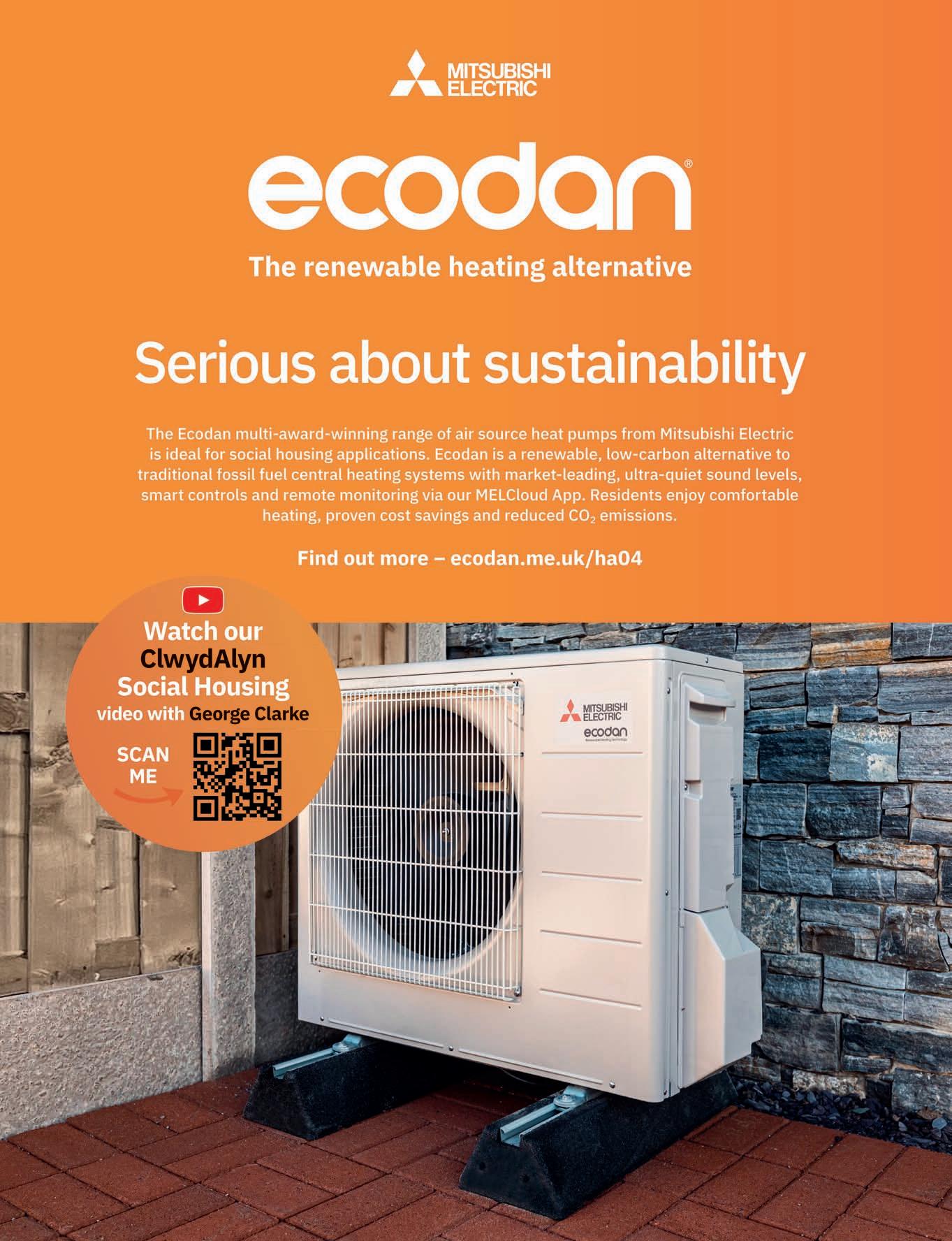
CONTENTS
FRONT COVER
Housing associations have a pivotal part to play in supporting the UK’s journey to net-zero but further change is needed if we’re going to get there. The UK has some of the most energy leaking housing in Europe, much of it built in the pre-war period. With just two years until the The Future Homes Standard comes into effect tougher regulations are very much on the horizon. Deceuninck has ambitious targets to slash CO2 emissions by 60% by 2030 through its corporate carbon reduction scheme. As part of this strategy Deceuninck has invested more than €15million in one of the world’s most advanced recycling and compounding facilities to create the capacity to reprocess up to 45,000 tonnes of post-consumer and post-manufacturing PVC-U per year. In real terms this gives it the capacity to prevent more than three million windows from going to landfill annually. Read more inside on pages 26/27
n HEATING, ENERGY EFFICIENCY, VENTILATION, CONDENSATION & MOULD CONTROL



14. There are many unanswered questions dealing with damp, condensation and mould
HA Magazine hears from Cornerstone on the challenges of resolving of damp, condensation and mould within a property and what can be done to deal with these issues more effectively.
n DOORS, WINDOWS, ACCESS & SECURITY
26. Are carbon reduction plans in social housing stuck in a rut?

Deceuninck discusses the company’s target to cut CO2 emissions by 60% by 2030 and how an investment of more than €15million in advanced recycling and compounding facilities will prevent over three million windows from going to landfill annually.
n EXTERIOR BUILDING ENVELOPE
34. Risk free with single source
Stuart Nicholson, Roof Systems Director at Marley, says that working with a single source roofing manufacturer, who understands the Part L regulations changes, can help mitigate risk in a changing regulatory landscape.
n FIRE PROTECTION & TENANT SAFETY

38. The Colt Service training centre: taking smoke control maintenance seriously
We hear from Tom Archer, Colt UK’s sales manager, about Colt’s new state-of-the-art training facility. Equipped with working examples of all types of smoke control systems the centre is designed specifically for the initial and ongoing training of their maintenance engineers.
n KITCHENS, BATHROOMS, INTERIORS & INCLUSIVE DESIGN
44. Reducing water and energy usage with shower specification
Sustainability is on the tip of everyone’s tongues. The knock-on effect for housing associations is that there is an expectation from buyers that new homes will be intrinsically ‘green’ through their design. Martyn Brown, Contracts & Technical Manager at Triton Showers, explores how shower specification can assist in creating eco and energy friendly homes.

n REFURBISHMENT & MAINTENANCE
50. Is your housing stock fit to live in?
With damp being a major complaint often raised by tenants, landlords, housing associations and social housing providers have a duty of care to rectify the issue. We hear from CorkSol UK about its sustainable and eco-friendly sprayed cork coating, SprayCork, designed for walls and ceilings to eliminate penetrating damp and condensation forming on surfaces.
n THE TEAM Publisher: Euromedia Associates Limited 10 Ashfield Road, Chorley, Lancashire PR7 1LJ 01257 267 677

Managing Director: Emma Hatherall
Sales: Laurence Sands laurence@hamag.co.uk 01827 301 185
Production: Kate Millward katem@hamag.co.uk 01827 301 192
Editor: Nick Lavigueur
Contributing Editor: Joe Bradbury
Press & Editorial Enquiries: please forward to press@hamag.co.uk 01827 301 192
Circulation Enquiries: please forward to admin1@euromedia-al.co.uk
Building Specifiers can subscribe free of charge to this magazine. To receive HA Magazine please visit: www.euromediaal.com/housingassociation-magazine
n PUBLISHER’S STATEMENT
HA is published ten times a year. Printed in England. All rights reserved. No part of HA may be reproduced or stored in a retrieval system or transmitted in any form without prior permission of the editor. Whilst every effort has been made to ensure the accuracy of the content, the editor and publisher do not accept responsibility for errors or loss and damage caused by any statement, claims or observations made by contributors, authors or their agents.
www.hamag.co.uk APRIL 2023 3 IN COMMERCIAL FENESTRATION
Magazine is an ABC certified publication
by Buxton Press Ltd
HA
Printed
Winners selected on £1.42bn materials deal for housing associations

City Electrical Factors, Huws Gray, Jewson, NMBS, Travis Perkins and Wolseley are among 13 merchants to have secured spots on a large-scale materials framework for UK housing associations and local authorities, worth up to £1.42bn over four years.
Launched by Procurement for Housing (PfH), the sixth generation of this framework sees a complete restructure with sixteen different lots allowing housing providers to procure plumbing, heating and gas, electrical and building materials, aids and adaptations, through either specialist merchants, managed stores (set up for their sole use) or branch networks.
The framework has a number of regional lots, enabling Scottish and Welsh housing providers to procure from suppliers local to them and it also offers self-serve options, so operatives can pick up materials even when branches are closed.

An ‘on-demand’ category enables housing associations and councils to use merchant branch networks for ad hoc purchases, when needed. Social landlords can also procure a tech platform that allows direct labour organisations (DLOs) and subcontractors to manage van stock, source products locally and have oversight of all spend across the framework.
The framework links with PfH’s widespread support for social landlords around asset management, which includes spend analytics reporting and a range of procurement insights delivered through its customer portal.
For a significant proportion of the social housing sector, buying materials for repairs, planned maintenance and retrofit accounts for over half their total spend. More than 450 housing providers used PfH’s previous materials framework.
Judy Ashcroft, materials category manager at PfH said: “Rising costs and severe shortages have made the last few years pretty turbulent for social landlords procuring materials. The cost of living crisis is compounding this with housing associations and councils seeing a spike both in demand for homes and their own costs. More than ever, certainty is needed so the sector can meet tough targets on improving stock, but social landlords also need flexible, forward-thinking ways to source materials and deliver insights so they can manage their spend effectively.”
About the Materials framework
n Lot 1 - Plumbing, Heating and Gas
• Wolseley UK Limited
• Jewson Partnership Solutions
• City Plumbing Supplies
• Huws Gray
• Travis Perkins
• UK Plumbing Supplies Limited
• National Merchant Buying Society (NMBS)
n Lot 2 – Electrical
• City Electrical Factors
• Edmundsons Electrical Limited
• Rexel UK Limited
• Jewson Partnership Solutions
• Huws Gray
• City Plumbing Supplies
• YESSS Electrical Limited
• National Merchant Buying Society (NMBS)
n Lot 3 - Building Materials
• Travis Perkins
• Wolseley UK Limited
• Jewson Partnership Solutions
• Huws Gray
• National Merchant Buying Society (NMBS)
n Lot 4 - Aids and Adaptations
• ProCare
• AKW Medi-Care Limited
• City Plumbing Supplies
• Jewson Partnership Solutions
• UK Plumbing Supplies Limited
n Lot 5 - National Consortia for Independent Merchants (NCIM)
• National Merchant Buying Society (NMBS)
n Lot 6 - Managed Store - National Supply (UK)
• Wolseley UK Limited
• Jewson Partnership Solutions
• Huws Gray
• Travis Perkins
• National Merchant Buying Society (NMBS)
n Lot 7 - Managed Store – Scotland
• Jewson Partnership Solutions
• Travis Perkins
• National Merchant Buying Society (NMBS)
n Lot 8 - Managed Store – Wales
• Huws Gray
• Jewson Partnership Solutions
• Travis Perkins
• National Merchant Buying Society (NMBS)
n Lot 9 - Managed Service - National Supply (UK)
• Jewson Partnership Solutions
• Wolseley UK Limited
• Huws Gray
• Travis Perkins
• National Merchant Buying Society (NMBS)
n Lot 10 - Managed Service – Scotland
• Jewson Partnership Solutions
• Wolseley UK Limited
• Huws Gray
• Travis Perkins
• National Merchant Buying Society (NMBS)
n Lot 11 - Managed Service – Wales
• Huws Gray
• Wolseley UK Limited
• Jewson Partnership Solutions
• Travis Perkins
• National Merchant Buying Society (NMBS)
n Lot 12 - Specialist Supply Service Route (SSR)Plumbing, Heating and Gas
• Wolseley UK Limited
• National Merchant Buying Society (NMBS)
n Lot 13 - Specialist Supply Service Route (SSR) –Electrical
• Rexel UK Limited
• Wolseley UK Limited
• YESSS Electrical Limited
• National Merchant Buying Society (NMBS)
n Lot 14 - Specialist Supply Service Route (SSR)Building Materials
• Jewson Partnership Solutions
• Wolseley UK Limited
• National Merchant Buying Society (NMBS)
n Lot 15 - On Demand Supply
• Huws Gray
• Travis Perkins
n Lot 16 - Multi-Vendor (Van Stock Management) Technology
• Inventor-e
• Stock Right Now
n HA ARTICLE 4 APRIL 2023 www.hamag.co.uk
Image © iStock
Image © iStock
Discover the tools to decarbonise buildings at InstallerSHOW
Article by Lucy Dixon, Head of Content, elemental.
Last year was elemental’s first as part of InstallerSHOW and, as our content takes shape for the 2023 event, it’s clear our focus on decarbonising buildings has never been more important.
With three days of inspiring and informative discussion on all the latest approaches to creating buildings that are ready for net zero, the elemental content theatres at InstallerSHOW 2023 will give visitors the tools and the connections to decarbonise existing buildings and new developments.
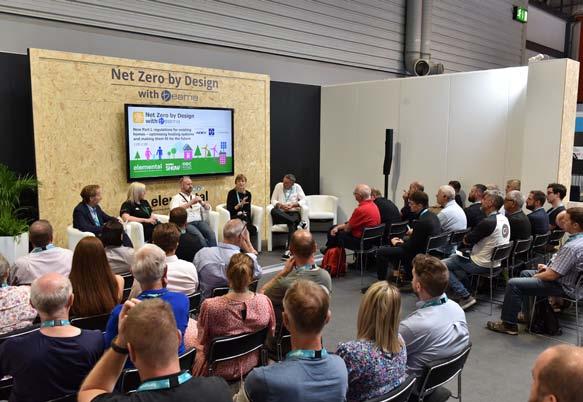
The topic of energy efficiency – how to tackle fuel poverty for households and keep energy costs down for businesses and organisations – is at the forefront of everyone’s mind as we grapple with record high energy prices, and will play a major part in our content at the show. There is also increased focus on water efficiency and indoor air quality, other important pieces in the net zero puzzle.
The two main elemental theatres – Decarbonising Buildings and the Housing Hub – will include sessions on everything from delivering low-energy retrofit in hardto-treat homes to the importance of improving heat network efficiency. Our confirmed speakers so far include Carbon Trust, Midland Heart, DESNZ, Orbit Group, Cundall, Heat Trust, Energy UK and Birmingham Energy Institute.
We have several exciting keynote speakers and hosts confirmed already, with former footballer and TV pundit Gary Neville joining us for a live Q&A – he is well known for his enthusiasm for energy-efficient buildings, plus his concerns about the number of people in fuel poverty and poor housing. We also have former
housing minister Esther McVey, Greenpeace director Ed Gillespie, environmental journalist Roger Harrabin and The One Show presenter, and eco writer, Lucy Siegle. More names will be announced in the weeks leading up to the show.
Scan the QR Code to register for your FREE ticket. We can’t wait to see you there.


Versatile pipe boxing from Encasement
Encasement’s range of pipe boxing and casings has been used across the UK for more than 15 years to conceal interior and exterior pipework in a range of social housing projects from fire sprinkler installations and heating system upgrades to low carbon district heating schemes.
Versa pre-formed pipe boxing is already installed in countless retrofit fire sprinkler projects to cover pipework in flats, lobbies and corridors, while for applications requiring a flame retardant solution, Versa FR pipe boxing provides an ideal solution.

For heating system refurbishment, Riva pre-formed pipe boxing is a quick, easy and cost-effective solution for concealing skirting level pipework, while boiler pipework, valves and flues can be hidden simply with Encasement’s ex-stock or bespoke boiler pipe casings.
All of Encasement’s plywood boxings and casings are manufactured, as standard, from UKTR compliant sustainably sourced timbers. Also, as they are pre-finished with a white decorative resin impregnated paper, they don’t require painting, which saves time and money on site.
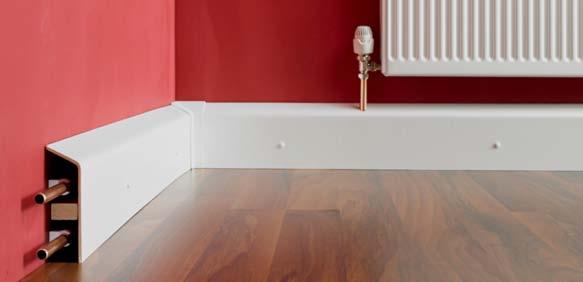
Where external gas supply and distributed heating system pipework needs protecting from accidental damage, tampering or vandalism, Arma metal boxing provides a tough and durable solution.
It is also increasingly being used to conceal air source and ground source heat pump installations, as well as interior sprinkler pipework in communal areas where no sprinkler heads are present, as Arma is non-combustible.

Bespoke manufactured from strong, lightweight and corrosion resistant aluminium, Arma profiles are usually specified with a PPC finish and can be readily secured to external walls using heavy-duty aluminium angle brackets and suitable fixings.
www.encasement.co.uk
www.hamag.co.uk APRIL 2023 5
Image © InstallerSHOW
Riva pipe boxing
Arma metal boxing
Versa FR pipe boxing
Images © Encasement
Innovative product guarantees airtightness in homes and lower energy bills

• Innovative product AeroBarrier guarantees level of airtightness for new-build homes
• Customers can choose desired airtightness, from Passivhaus to Building Regulations
• Well established internationally in the US, Canada and UAE, it represents the first time that the product’s been available in this country
An innovative sealing system for buildings aimed at boosting energy performance levels, was launched in the UK at a major house building conference last month.
AeroBarrier, which made its debut at the Homebuilding and Renovating Show at the NEC last month, has been designed to allow properties to be constructed with guaranteed levels of airtightness.
The product’s designers say it can make a huge difference in the warmth of properties and thus reduce the need for heating.
Its patented technology uses a modified blower door test to pressurise a building to specific levels, before spraying a non-toxic mist coat that seals any leaks. Continual testing is carried out during this process to provide real-time updates to assess the level of airtightness. Once the desired results have been achieved the process is stopped.
Air movement occurs in two forms, deliberately controlled ventilation, such as air supplied through a mechanical system or a controlled opening, or infiltration, which is unintentional air movement through cracks and gaps in the building fabric. Infiltration leads to heat from the house being lost, increasing energy costs and lowering the EPC rating.
If sufficient attention isn’t paid during the design and construction stages of a project, there is a risk that the building will fail its airtightness test. Carrying out remediation work and retests when this happens can lead to delays and increased costs.
A Masterclass Theatre talk at the show from head of AeroBarrierUK, Hugh Franklin, explained how airtightness can guarantee lower energy bills.
“AeroBarrier is three times faster than traditional caulk and tape methods,” he explained.
“It helps remove any concerns about human error or airtightness test failures during the build process, so is hugely positive from a quality assurance perspective.

“For residents and homeowners, better airtightness levels reduce energy bills and create healthier living conditions.”
Able to tackle gaps of up to half an inch in size, AeroBarrier can achieve airtightness ratings that range from the UK building standard of 5m3/hm2 to a recent Passivhaus result of 0.11m3/hm3
The sealing process takes place once the building has been completed to the second fix stage, to reduce the amount of time and effort spent on clearing up after the process and protecting surfaces. Before the process is carried out, the building is prepared, with all openings that should not be sealed, such as vents or fireplaces, and horizontal finished surfaces covered.
Using a blower door test, the team analyses the data readings in real-time to track the distribution of sealant in the space. Once the desired level of airtightness is achieved, the sealing process is

completed, and a final blower door test is carried out to verify the air sealing results. Once the installation team have undertaken post-sealing tidy-up, other site-work can resume after about half an hour. Following sign-off from the client, a Certificate of Completion is provided to show the pre- and postleakage results.
The sealant is a water-soluble organic compound and is proven safe. It has ultra-low volatile organic compounds (VOC) and because it is inactive, there is no chemical reaction needed to form a seal. This means there is no off-gassing or air-borne release of harmful chemicals, such as some VOCs, into building envelopes.
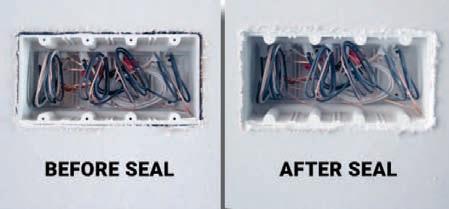
Already established internationally in the USA, Canada and the UAE, AeroBarrier has been used on projects from one-off self-builds to large government contracts. It is available exclusively in the UK via Oakwrights, a developer of bespoke oak-framed buildings.
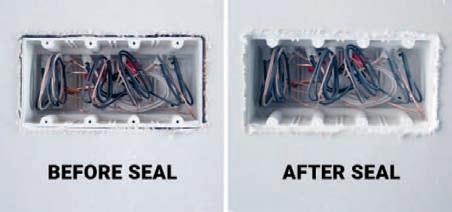
n HA ARTICLE 6 APRIL 2023 www.hamag.co.uk
Hugh Franklin
AeroBarrier blower door set up
Learn more about AeroBarrierUK on the website aerobarrieruk.co.uk
Before and after AeroBarrier
Images © AeroBarrierUK

Poverty and stress go hand in hand
As April is National Stress Awareness Month, Charis business development director, Ollie Gray, underlines the importance of flexibility, speed and efficiency in alleviating the effects of the financial crisis that is hitting individual households across the UK.

Every month as bills rise and inflation erodes income, householders are facing harder and harder choices when it comes to prioritising bills, shopping, and other household expenses. The impact on their mental health is plain to see. In 2022, 83.4 million antidepressants were prescribed - a 5% increase from the year before.
As interest rates and inflation continue to bite deep, the stress of making ends meet is only going to drive these numbers up yet further.
That stress is exacerbated by a number of different issues. One of the key issues is unpredictability, which leads to high levels of stress and anxiety. It’s the unpredictability of whether or not there will be enough money at the end of the month. It’s the unpredictability of what energy and shopping prices are going to do next. It’s the fear of what would happen if the washing machine broke down or the cooker.
Added to this is the overriding lack of any sense of control over their situation. As prices spiral, all you can do is stand and stare in shock and disbelief at the absolute erosion of any spare cash left in your bank account while there are still days, if not weeks, till the next payday!
And any stress in a household felt by parents is transmitted, usually unwittingly, to the children. The ramifications of this current cost of living crisis will be felt for many years to come.
Charis has evolved its Charis Shop platform to give housing associations and social landlords as much flexibility as possible to alleviate the stress that their residents are experiencing. Hunger and warmth continue to be prominent themes, with over 1000 food and energy vouchers distributed daily. However, a recent report issued by Barnardo’s reported how the lack of basic essentials and furniture was also impacting families.
The report stated that 41 per cent of parents surveyed struggled to replace essential items - these items ranged from washing machines and fridge freezers to furniture, and particularly beds. Many families reported that children were sleeping in the same beds as their parents or sharing a bed with their siblings. Some parents had even given up their own beds and were sleeping on sofas.

Speed and efficiency are vital when it comes to alleviating the stress felt by families who are wondering how to put food on the table. Charis was originally established to help energy and utility companies redistribute funding to those in fuel poverty. With the development of the Charis Shop, it soon became clear that there was so much more potential for using the platform for a number of different applications and helping a much wider proportion of the demographic that needed to be explored.
As well as negotiating agreements with white goods distributors, such as Whirlpool and AO, whereby housing associations can, within minutes, run an eligibility check and order replacement items (with
all the delivery and installation details sorted by Charis), Charis has taken the range of products yet further.
A partnership agreement with Tillo has expanded the range of items and brands on offer, including Argos, B&Q, Currys, and Ikea. General supermarket brands include Aldi, Asda, Farmfoods, Morrisons, Sainsbury’s, and Tesco. Housing Associations can also now provide hot food vouchers through Just Eat, Deliveroo, and Uber Eats for those who do not have the facilities to cook their own hot food or are in desperate situations. Clothing vouchers can also be redeemed at Primark.
Maintaining a certain standard of living is vital to stave off the worse of the stress and anxiety and feel as though you are not slipping uncontrollably into the depths of poverty and despair. For some, knowing that support is available and access to a hot meal can be all it takes to take the edge off that stress. Our Housing Association partners can issue this in seconds.
www.charisgrants.com
n HA ARTICLE 8 APRIL 2023 www.hamag.co.uk
Image © Stock-Asso
Ollie Gray, Charis business development director Image © Charis
“Maintaining a certain standard of living is vital to stave off the worse of the stress and anxiety and feel as though you are not slipping uncontrollably into the depths of poverty and despair.”
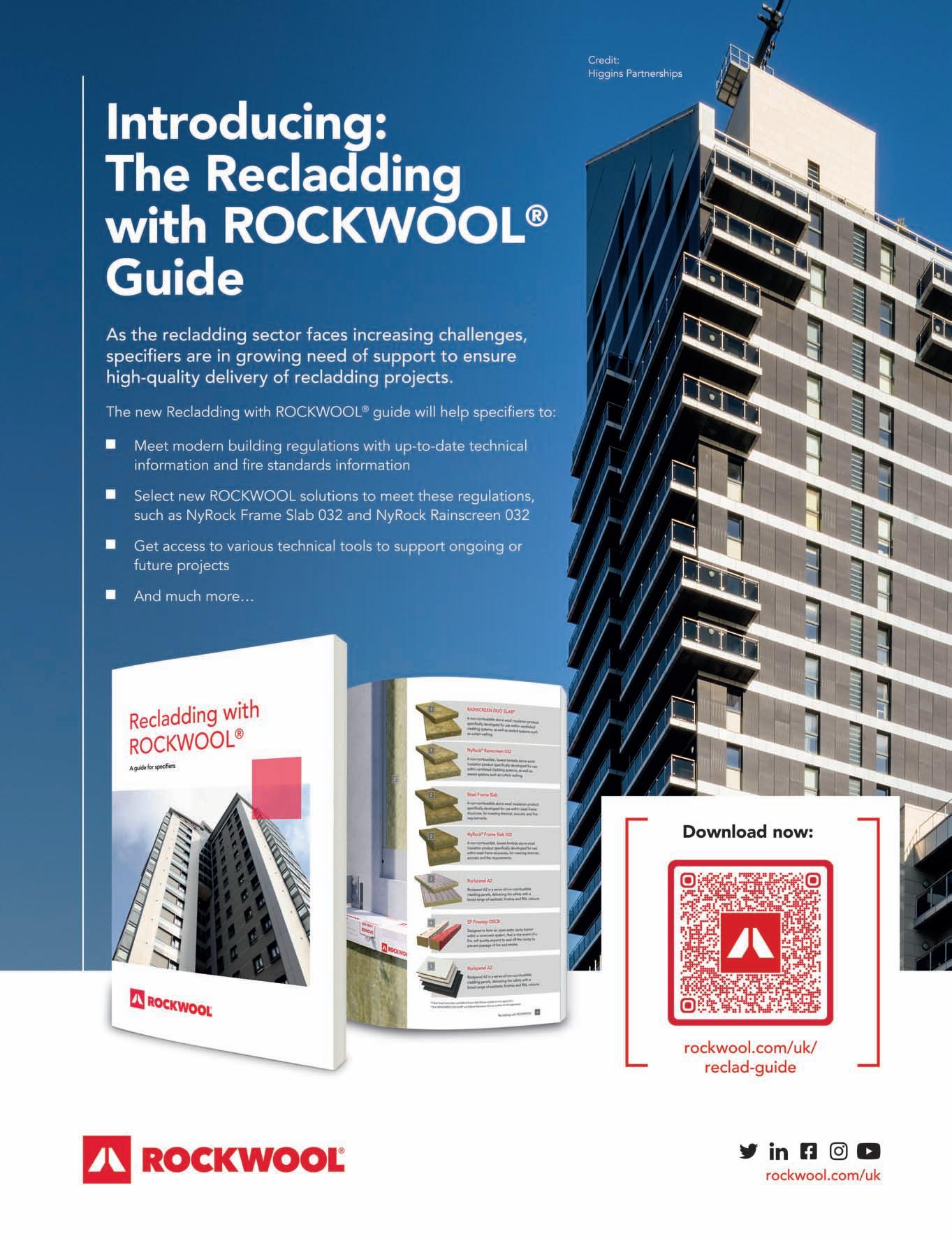
Housemark publishes first look at sector performance on Tenant Satisfaction Measures
The current performance of housing providers in England against the new Tenant Satisfaction Measures has been revealed for the first time.
Key findings from the analysis by Housemark, of data it has gathered from its members for the 22 TSMs, include:
• Overall tenant satisfaction has decreased by around five percentage points since 2020 to 79% today. The picture for shared owners is even more stark with only 56% satisfied
• Fewer than two-thirds of residents (64%) feel that their landlord listens to their views and is minded to act on them
• Yet, 83% of tenants say their landlord treats them fairly and with respect; 75% say they are kept informed about the things that matter to them
• Landlords are performing well on all safety measures, with a median score of 100% on all five areas
• By contrast, only 83% of tenants say they are satisfied their home is safe
• 85% of non-emergency repairs are completed on time against landlord targets, but the average days to complete repairs has increased by 40% to around 14 days since 2020
• 8 in every 10 tenants say they are satisfied with repairs; 76% are satisfied with the time taken to complete the most recent repair
• Only 68% of tenants say their landlord keeps communal areas clean and well-maintained
In addition, 8 in 10 tenants receive a response to a complaint within the 10 days required. Just over half of tenants (56%) say they are satisfied with their landlord’s approach to handling complaints.
Satisfaction with how their landlord handles antisocial behaviour is also low with a median score of just 60%.
Housing providers are required by the regulator to measure and report their performance against the 22 TSMs from 1 April. Registered Providers owning more than 1,000 shared ownership properties (around 50 landlords) must publish separate survey results for this group.

Jonathan Cox, Director of Data and Business Intelligence at Housemark, said: “We want to help housing providers get ready for significant regulation changes coming in from 1 April. As part of this, we have been working with our members to gather data

against the 22 Tenant Satisfaction Measures since they were finalised in September. Although our data only gives an early indication of performance based on limited sample sizes, some striking trends are emerging that can inform landlord decision-making.
“There is clear potential for landlords to improve listening to and acting on tenant feedback, as well as how they engage with tenants. Changes here could help to address the decline in overall tenant satisfaction that our analysis highlights.”
Jonathan added: “It is not too late for housing providers to get ready for these regulation changes and ensure they are able to gather the required data in the right way from 1 April. This is something that Housemark has been supporting housing associations, local authorities and ALMOs to do across the country.”
Wherever possible, the Housemark data reflects tenant perceptions of their landlord’s service in line with the requirement set out by the Regulator of Social Housing for the TSMs.
The full survey findings are available free-to-access on the Housemark website [www.housemark.co.uk/ news/housemark-publishes-first-look-at-sectorperformance-on-tenant-satisfaction-measures] Regular updates on the TSMs using Housemark data will be provided to Housemark members.
Further information is available on Housemark’s website on how housing providers can get ready for regulation changes that began on 1 April.
n HA ARTICLE 10 APRIL 2023 www.hamag.co.uk
Jonathan Cox, Director of Data and Business Intelligence at Housemark Image © Housemark
“There is clear potential for landlords to improve listening to and acting on tenant feedback, as well as how they engage with tenants...”
Image © Adobe Stock
How to save energy with your Sunparadise balcony enclosure
Looking to increase energy efficiencies on your housing stock? This is why Sunparadise balcony enclosures are now so popular throughout the UK on both new build and refurbishment properties.


How do they save energy?
The frameless glazing, with minimal sight lines, on this secondary façade has many opening variations to maximise energy efficiency of the space, whatever the weather, and this is how it works. By positioning the apartment door/window leading onto the balcony space and the balcony glazing itself, you can maximise the energy saving benefits of natural solar gain and natural ventilation to your advantage.
Warmth for free
• Close balcony glazing
• Air warms in balcony space
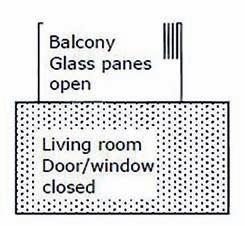
• Open inner door/window
• Warm air circulates indoors






• Air will warm even on cloudy days Particularly useful in Spring & Autumn
Protect against the weather
• Close balcony glazing
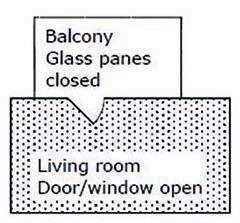
• Close inner door/window
• Balcony provides barrier to the cold and the wind
• Do this on cold days or at night to save on heating bills
Keep cool in hot weather
• Open balcony glazing fully
• Close inner door/window (close out the heat)
• Warm air escpaes the balcony
• Inner room remains cooler
• Useful on still, hot sunny days and evenings
Circulate fresh air in hot weather
• Open balcony glazing fully
• Open inner door/window
• Fresh air from balcony comes into inner room

• Open other windows to help fresh air draw through
Enjoy warmth and fresh air
• Turn one balcony pane in and space remaining glazing
• Close inner door/window
• Balcony glazing generates some heat from the sun but provides some protection from wind
• Fresh air enters balcony space
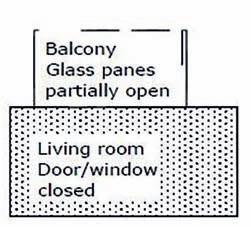
Sunparadise give full training to residents on how to use their Sunparadise balcony enclosure, including this energy saving guidance.
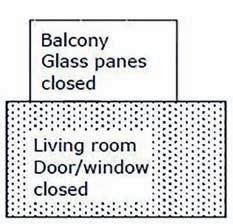

For further information scan the QR code or contact John Baillie on 0870 067 8810 www.sunparadise.com

Bring warmth and fresh air into home
• Turn one balcony pane in and space remaining glazing
• Open inner door/window
• Balcony glazing generates some heat from the sun but provides some protection from wind
• Warmed fresh air enters home
www.hamag.co.uk APRIL 2023 11
Nottingham City Homes’ Winchester and Woodthorpe demonstrate multiple opening options of glazing. Image © Scopic Productions
New programmable room thermostat launched by ESi
• RTP4 Touch offers ‘better’ response in company’s ‘Good, Better, Best’ line up

With a reputation for helping homeowners and tenants to control their heating costs as the cost of living continues to rise in the UK, ESi has responded to the current economic climate with the introduction of its latest quality heating control – the RTP4 Touch programmable room thermostat.

This latest introduction is capable of controlling heating and hot water systems via combi, system or heat only boilers.
When installed with the ESi WIFI hub, homeowners and tenants heating and hot water can be controlled via Alexa or the ESi Centro App. Vitally, the load compensation functionality, available via OpenTherm technology, modulates the flow temperature dependant on the desired room temperature, saving up to 15% on gas usage – a benefit not to be overlooked in the current situation where energy prices have leapt to a huge new high in the UK.
The 4 Touch has a large backlit LCD display and touch screen making it simple-to-use and programme.
The RTP4 Touch slots in neatly between ESi’s best selling RTP4RF units and its top of the range 6 Series WIFI programmable room thermostats, offering many of the benefits of both these ranges but providing additional benefits as well. It offers optimum start/stop and delayed start functions offering additional cost savings for users, 7 day, 5/2 day or 24 hour options to suit the homeowner or tenants lifestyles, automatic summer/winter change settings and has home, manual, away, sleep and holiday modes long with its popular landlord service interval reminder which makes it a perfect fit for social housing providers looking for a compliant heating control.
The new unit is battery controlled and comes with a low power indicator to show simply when the battery needs replacing. And the new control comes with a 3-year warranty to give owners complete peace of mind.
ESI CONTROLS: www.esicontrols.co.uk
Marmox Thermoblocks cutting carbon for social housing residents

Work is well underway on the first phase of an affordable housing project for Somerset West and Taunton Council, where the use of Marmox Thermoblocks was put forward by specialist developer, Equans Regeneration (formerly Engie Regeneration) which is leading the work on the site in Taunton.
Phase A of North Taunton Woolaway Project will see the construction of 47 new one, two and three bedroom properties for local people with energy saving and the reduction of environmental impact both being given full consideration during the design and planning. The issue of thermal bridging, in particular, is being addressed through the decision to utilise the highly insulating Thermoblocks around the perimeter of the ground floor slabs.
Some 600 of the 65mm deep, 100 x 600mm Thermoblock units have been supplied to date along with 30 tubes of the Marmox 360 multipurpose adhesive. Each length of Thermoblock is comprised of ultra-high performance XPS insulation, encapsulating miniature epoxy concrete columns, while the top and bottom are covered by alkali resistant glass-fibre mesh, retaining a surface of fibre reinforced polymer concrete to facilitate bonding.
The concrete columns have a very low conductivity, so do not present thermal bridges themselves and when coupled with the highly insulating XPS insulation core, a combined thermal conductivity of 0.47W/mK is achieved.
Crucially, being able to employ a defined, very low thermal transmittance – derived by thermal modelling or measurement – offers a far more advantageous result than adopting the ‘default’ figure offered in SAP, which can often result in non-compliance under Part L.
MARMOX: www.marmox.co.uk
Groupe Atlantic makes major investment in Clade Engineering Systems
Clade Engineering Systems (Clade), the UK’s leading manufacturer of natural refrigerant CO2 heat pumps, is partnering with Groupe Atlantic’s UK, ROI & North America Division. Clade manufactures natural refrigerant CO2 heating and refrigeration solutions for the UK, offering a turnkey solution from design and manufacture through to aftercare.

As the number one in commercial and domestic heating across Europe, this partnership reinforces Groupe Atlantic’s strategy to be at the forefront of low carbon heating solutions, offering the largest portfolio of heating products in the UK. Clade will join forces with the market-leading commercial brands from Groupe Atlantic, including Ideal Commercial Heating, Hamworthy, ACV and Keston. A specialist in helping customers reduce carbon emissions, their range of energy-efficient heat pumps can generate from 50kW to >1MW, offering extensive choice for customers in the retail, commercial, industrial and public sectors. With their expertise in natural refrigerant technology and heat pumps, Clade substantially upscales Groupe Atlantic’s commercial offering, providing customers with even more choice on an industrial scale.
Going beyond the manufacturing of heat pumps and refrigeration, Clade provides a complete end-to-end solution to maximise performance and energy efficiency of their innovative and cuttingedge technology. This includes maintenance, aftercare and digital services to optimise performance and energy efficiency through condition monitoring, remote diagnostics and analytics.
GROUPE ATLANTIC: www.groupe-atlantic.fr/en/
Baxi Combi Ranges prove a hit with Installers
Baxi’s latest 200 and 400 combi 2 boiler ranges are proving to be a popular choice with installers, thanks to the introduction of a series of new and improved features making installation as seamless as possible. Lightweight and compact, the cupboard fit boilers include an upgraded and simpler wiring experience, brass hydraulics on the Baxi 400, increased LPG options across the range, stainless steel heat exchanger and both ranges have easy-to-replace components. Providing installers with greater flexibility to meet the requirements of a variety of domestic properties –large and small – outputs range from 24kW for both natural gas and LPG in the Baxi 200 Combi 2, up to 30kW in the new, higher-output addition to the Baxi 400 Combi 2 range.
Manufactured with emissions reductions and efficiency goals in mind, both models are 80/20 hydrogen certified to run on a 20% hydrogen blend.
BAXI: www.baxi.co.uk
n PRODUCT NEWS 12 APRIL 2023 www.hamag.co.uk
Image © ESi
Image © J. Ward Turner Publicity Ltd
Image © Groupe Atlantic

There are many unanswered questions dealing with damp, condensation and mould
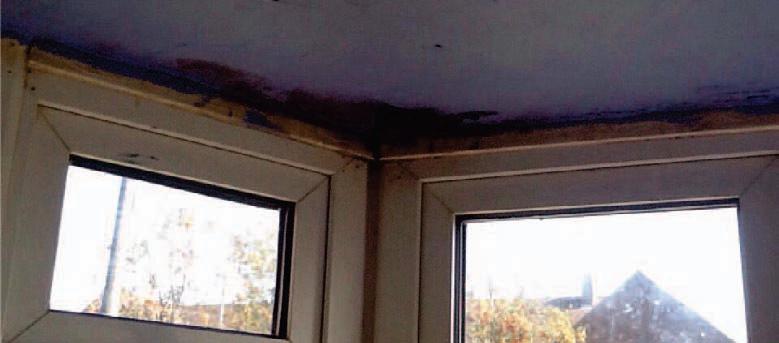
• Is damp and mould on the increase?
• Are we ready to fix the problem?
• Do we know enough about the causes?
• Will the drive to insulate homes add to the problems?
• Why is the mould returning after it has been cleaned off?
• Why have I now got mould on my clothing and furniture items?

• Is my house damp?
A case example was an outbreak of mould in a bedroom found to be due to a number of contributory issues combined that was disputed by a local authority as a lack of ventilation in the kitchen. Their intended ‘repair’ to install an extraction unit, although compliant with today’s applicable regulations, would not have solved the reported issue alone and, is typical of today’s damp and mould resolution approach.
Dealing more effectively with damp and mould requires a better understanding of atmospheric behaviour alongside all contributory elements and, it is recognised there is currently no formal training qualification that embraces all aspects of property health investigations.
permeability that as a collective, can affect the breathability and installed ventilation effectiveness of the dwelling as a whole.
For landlords, changing from a ‘reactive’ to a ‘proactive’ approach will likely form a process-change within their organisations and, Cornerstone can assist that journey with bespoke, selectable process improvements and support aligned to their existing significant and demonstrable experience.
Cornerstone data representing approximately 3500 independent investigations of reported damp, condensation and mould, indicate 92% of the surveys suggested a ventilation related issue as the root cause.
Issues typically range from inadequate ventilation for the property type and occupancy level, isolated devices due to noise or cost reduction, units in or close to open windows being ineffective for the room as a whole, internal doors removed allowing moist air to travel through a building, drying clothes internally and a lack of provided knowledge aligned to the device capability and its important use.

Therefore, if you are still having trouble resolving damp and mould problems even after remedial repairs, isn’t it about time a uniform framework was established for assessing structures today, followed by assessments tomorrow, post any works in order to certify ‘adequacy’ and ‘compliance’.
As an independent surveying company, Cornerstone are acutely aware of the frustrations with repetitive mould outbreaks and repeat repairs that have not resolved the issues.
One typical key understanding is that damp, condensation and mould are symptoms of a problem and, root causes can only be determined with an open collective approach and not a singular delivery aspect.
Recognising the age, type, geographical location and orientation of homes throughout the UK embraces a host of significant variations, it is essential a fresh approach embracing synergy across a number of industry sectors is crucial in recognising existing status elements such that, any planned ‘improvements’ can be assessed and concluded with a better understanding of their residual impacts.
The challenge of a decarbonisation journey could, in the absence of defined knowledge of a dwelling type and its use, lead to unforeseen secondary issues. For example, all building materials have a level of

Such assistance ranges from CPD accredited understanding of atmospheric and structural moisture in buildings to understanding specialist equipment used to uphold survey findings alongside their accurate data interpretation.
Where Cornerstone have delivered SMART Knowledge, it has been shown to uphold better decision making and re-spend reduction – for the long term.
For more information: www.cornerstone-ltd.co.uk • www.propertymot.uk enquiries@cornerstone-ltd.co.uk 023 9200 9270


n HEATING, ENERGY EFFICIENCY, VENTILATION, CONDENSATION & MOULD CONTROL 14 APRIL 2023 www.hamag.co.uk
“One typical key understanding is that damp, condensation and mould are symptoms of a problem...”
Images © Cornerstone

Don’t let heating costs go through the roof
With energy costs quite literally going through the roof, it’s never been more important to prevent heat loss in homes, offices, factories and business premises.
Reducing heat loss in a building through strategic interventions such as minimising air leakage [draughts] and the installation of high-performance insulation are obvious first step solutions. Both are measures that the Government is encouraging the whole country to embrace as a matter of urgency.
Unfortunately, in the UK we are starting from a rather low base line as we have some of the least energyefficient housing in Europe - largely because much of the housing stock is so old.
Records show that the UK has roughly 29.3 million domestic properties, 36% of which were built before World War Two when little thought was given to insulation and heat loss mitigation.

The challenge is clearly enormous so what can be done to turbocharge the process of reducing energy consumption?
Improving the thermal performance of new buildings is relatively straightforward and modern standards of construction are helping – the real challenge is in retrofitting insulation to old and difficult to treat buildings.
One company at the forefront of insulation technology believes it has an answer.
Huntsman Building Solutions – part of Huntsman Corporation and recently formed following the acquisition of three existing spray foam insulation brands – Demilec, Lapolla and market leading UK and Republic of Ireland based system, Icynene.
The merging of these three brands under the Huntsman Building Solutions [HBS] title created an organisation formed to bring innovative solutions to the market which had principally offered only traditional forms of building insulants such as mineral wool and rigid board-type products.
Spray foam insulation solutions differ from conventional types in that they are applied only by specialist contractors using bespoke equipment not usually available to the general building industry.

n Breathable, high-performance insulation
Spray foam insulation is applied as a two-component mixture that comes together forming a breathable foam that expands 100-fold within seconds of application, sealing all gaps, service holes and hard to reach spaces in a building – crucial in retrofit applications.
Modern spray foams such as HBS H2 Foam Lite use water as the blowing agent. This means that the reaction between the two components produces CO2 which causes the foam to expand. As the material expands, the cells of the foam burst and the CO2 is replaced by air.
This creates an open cell foam structure with a soft, yielding texture that provides outstanding insulating properties and lets the building breath naturally, resisting internal condensation.
In recent years and mainly under the HBS legacy brands, spray foam insulation has been used successfully in a wide range of applications including private housing, commercial, industrial, multi occupancy dwelling and refurbishment, together with high end architectural and some of the most innovative construction related projects. Here we take a look at a small selection.
n Commercial refurbishment
The Battery is an imposing Victorian era hotel on the seafront of Morecambe Bay – quite literally facing

n HEATING, ENERGY EFFICIENCY, VENTILATION, CONDENSATION & MOULD CONTROL 16 APRIL 2023 www.hamag.co.uk
Records show that around 36% of UK properties were built before World War Two, when little thought was given to insulation and heat loss mitigation. Image © Shutterstock
Spray foam insulation solved a tricky insulation challenge in a five-story steel framed apartment building in Southwest London. Image © Holmes Media
The Battery is an imposing Victorian era hotel on the seafront of Morecambe Bay – quite literally facing into the teeth of the winter gales. Image © Holmes Media
into the teeth of the winter gales that can tear across the exposed Lancashire coastline.
Recently purchased by developer, Ian Bond, the run-down four-story building has been gutted and re-engineered to create high end serviced holiday apartments.
“Our aim is to get to near Passivhaus standards of insulation and air tightness. HBS Spray foam insulation has been used on all external walls to create a thermally efficient, near sealed-box environment. We’ve incorporated solar panels, air sourced heat pump technology for underfloor and water heating and each of the seventeen apartments has automated mechanical ventilation and heat recovery systems. Energy consumption is very low.” reports owner Ian Bond.
n Multi-occupancy steel-frame new-build Spray foam insulation solved a tricky insulation challenge in a five-story steel framed apartment building in South West London.
The building’s internal structure is a complex latticework of galvanised C-section steel framing. Whilst quick to design and construct, installing the required thermal insulation and preventing air leakage in the finished building was extremely difficult.
Steel framed buildings are generally harder to insulate than masonry or timber framed structures. Steel conducts heat 300-400 times faster than timber and can reduce the efficiency of wall insulation by as much as 60% because of thermal bridging. Fitting conventional rigid board or mineral wool insulation into the steel structure was pretty much impossible - There would have been too many fiddly cuts and small fillets. Contractors could not have made it work to a high enough standard.
For a solution, Contractors Devcon specified HBS spray foam insulation, capitalising on its incredibly “searching” nature that helps foam get into and seal tiny voids that would otherwise allow air leakage and heat loss through the structure.
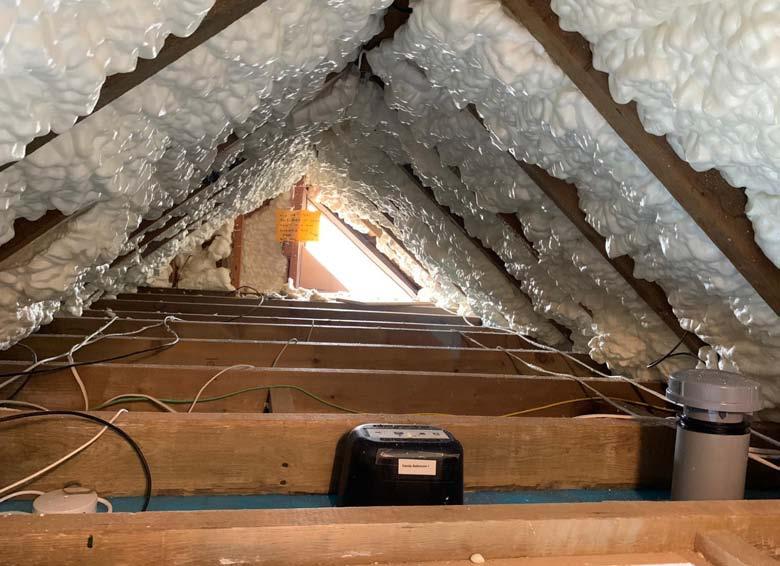
n Private housing retrofit
Originally built in the late 1980’s, this modern looking property has oil fired central heating and fuel consumption was felt to be high.
A comprehensive survey was undertaken to assess thermal performance of the building and a “Fabric First” approach to improving the efficiency of the walls and loft areas was proposed – a methodology in keeping the Government’s recently published Heat and Building Strategy.
Because of the complex nature of the first-floor roof and dormer structure, contractors removed roof tiles and stripped back membrane to allow access for installation of HBS spray foam insulation.
Foam was sprayed between joists and the membrane repaired and tiles replaced. Similarly, cladding to the front and rear dormers was removed to allow spraying, with cladding later replaced.
Excellence [COE], installer training facility at their King’s Lynn factory site – believed to be the first of its kind in the UK.
Here, existing installation contractors as well as new teams looking to join the industry, go through a comprehensive training programme which leads to a “Certificate of Application Training” and Authorized Contractor status. Only Huntsman Authorised Contractors are allowed to install HBS systems and Huntsman Building Solutions sees this programme as vital in raising quality and safety standards and creating recognised trade qualification throughout the industry.
For the main front and rear gables, existing timber cladding was removed to allow disposal of the original fibre-glass insulation that had sagged and failed. These areas were sprayed externally and new cladding reinstated.

On completion of the works a further thermal performance survey was undertaken showing clear improvement in heat retention, a significant reduction in air leakage and an estimated 75% improvement in overall thermal efficiency.

UK Centre Of Excellence training facility
In order to raise standards in this sector of the construction industry, Huntsman Building Solutions has established what they describe as a Centre of
n Build tight, ventilate right Huntsman Building Solution’s aim over the next few years is to promote the benefits of spray applied insulation in both new-build and retrofit applications and promote best practice in spray foam insulation.
Better insulation, eliminating air leakage and the introduction of managed building ventilation are seen as crucial in improving building standard in the UK. Important long-term goals that will bring real environmental benefits. All neatly summed up in the HBS mantra, “Build tight, ventilate right”
For more information on Huntsman Building Solutions please visit: www.huntsmanbuildingsolutions.co.uk
www.hamag.co.uk APRIL 2023 17
A “Fabric First” approach to improving thermal efficiency – a methodology in keeping the Government’s recently published Heat and Building Strategy Image © Shutterstock
Spray foam insulation completely fills the difficult to reach construction voids.
Image © Prize Spraying Ltd
“Better insulation, eliminating air leakage and the introduction of managed building ventilation are seen as crucial in improving building standard in the UK.”
1980’s private house required major retrofitting of insulation.
Image © Prize Spraying Ltd
Driving a low carbon future with heat pumps
A new wave of government funding is driving fresh opportunities for social housing providers and developers to decarbonise their UK housing stock. Adam Greaves, Panasonic Key Account Manager – Heating Solutions, puts forward the case that embracing renewable technologies such as installing heat pumps can have a significant effect in meeting net-zero goals.

The second wave of funding for social housing decarbonisation1 will provide £1.8bn to upgrade the energy efficiency of homes and public buildings. With £778m specifically allocated to decarbonising social housing, providers can look to renewable technologies that not only provide the required heating and hot water but will also meet low carbon targets for both new and existing properties.
Alternative energy efficient and effective systems are required to replace the traditional gas/oil-fired boiler for heating and hot water provision. Making the switch to unfamiliar technologies can be challenging, particularly for tenants used to conventional systems. However, there is a lot of support available and housing providers must work closely with manufacturers who can play a key role in providing easy to understand resources, product knowledge and training for specification, system design and installation, operation, monitoring and management.
n The right technology & resources
In tune with the increasing regulations in the housing sector, manufacturers have greatly increased their portfolios of sustainable energy solutions. One example is the Panasonic Aquarea air-to-water heat pump range, specifically designed to meet the needs of housing providers wanting to reach compliance with regulations. Panasonic recently worked with Stroma Group, a leader in accredited sustainability and compliance services for the construction industry, to carry out independent tests on how Aquarea air to water heat pumps perform to the new SAP10 BRE approved software calculation tool. The Panasonic Aquarea range of air-to-water heat pumps came out highly favourable in these tests compared to competitor units currently on the market.
Not only a compliant technology therefore, but also Panasonic Aquarea units are reliable, quiet in operation and highly energy efficient. Performance can be further enhanced when the system is linked to smart cloud controls such as the Panasonic Smart Cloud and Service Cloud apps. The Service Cloud app can make service and maintenance for housing providers easier, with remote monitoring, troubleshooting and the ability to pre-empt any issues before they become a problem.
Panasonic offers a wide range of A+++ energy class (average climate at 35°C), rated units that have a SCOP of 5.12 with potential energy savings and costs to the tenant or resident of the property2 and offers an appropriate unit for all sizes of properties. An Aquarea mono-bloc unit can be particularly attractive, housing everything needed for the heat pump in one self-contained outdoor unit, making it easier to install and maintain.
n Reliable and Deliverable
A determining factor for a fast move to renewable technology is selecting a reliable heat pump manufacturer capable of delivering within schedule. In projects such as a recent install at the Palace Green Homes development in Cambridgeshire, installers faced supply chain issues which made progressing the development a real challenge. However, Panasonic stepped in to supply the Aquarea heat pump units on time and connect to the development’s existing piping and wiring to get the entire project back on track and within the predetermined timescales.

Roland Gurner, air to water specialist at Oceanair, who worked with CG Plumbing at Palace Green Homes explained: “One thing that was clear from the offset of this project was that it was vital that we could provide continuity of supply during this current supply chain crisis. Panasonic provided very good ongoing support throughout, and we therefore were able to very quickly secure the stock required.”
n Installer Show




The team from Panasonic is exhibiting at Installer Show 2023 (NEC, Birmingham 27th – 29th June, Stand D20). The team will be on hand to demonstrate the Aquarea range along with intelligent smart controls showcasing how users can monitor and keep track of energy usage to help cut costs.
For more information on the Panasonic range of low carbon solutions, please visit www.aircon.panasonic.eu
1 https://www.gov.uk/government/news/18-billion-awarded-to-boost-energy-efficiency-and-cut-emissions-of-homes-and-public-buildings-across-england 2 Find out how we ensure accurate and up to date data (energysavingtrust.org.uk)
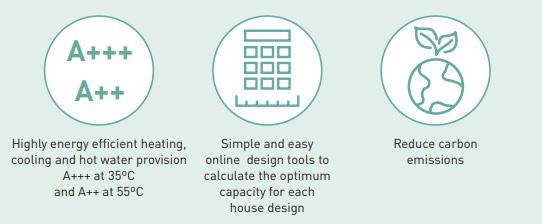
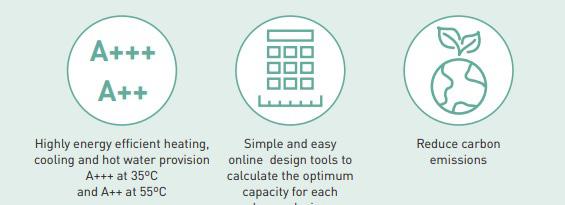
n HEATING, ENERGY EFFICIENCY, VENTILATION, CONDENSATION & MOULD CONTROL 18 APRIL 2023 www.hamag.co.uk
Images © Panasonic
Adam Greaves

Key recommendations from the Skidmore Report
Joe Bradbury looks at some of the key findings for social housing from this seminal report on Net Zero
The Skidmore review is the result of one of the largest Net Zero engagement projects in the UK.
Chris Skidmore MP and his team at the Department for Business, Energy and Industrial Strategy (BEIS) gathered almost 1,800 pieces of written evidence and spoke with hundreds of industry and civil society leaders in just a few months.
The ensuing paper provides a thorough examination of how the UK’s Net Zero aim by 2050 might be met in an economically beneficial manner.
The cheapest energy is the energy we do not use, and by strengthening home insulation and heating systems, we will have warmer, cleaner homes going forward.
Switching from fossil fuels to renewable energy could save the world as much as £10.2tn by 2050, according to a study by Oxford University.
n Consider a Net Zero Homes standard now
All homes should ideally be held to a Net Zero Homes Standard as the industry standard.
Homes that have taken the necessary efforts to be as efficient as possible can save their occupants money on their bills and be more financially desirable to future buyers by combining fabric and low carbon heating techniques.
By establishing a Net Zero Homes Standard, it will be possible to assure that over time, an increasing number of homes will meet this standard and an increasing number of occupants will live in homes that are both financially and physically beneficial.
The government should be praised for recent energy efficiency efforts, such as demand reduction targeting, but we must go further and faster if we wish to make a meaningful impact on our carbon footprint as a society. The Review recommends that:
• The government provides all consultations and work to mandate the Future Homes Standard by 2025 and EPC C for all homes sold by 2033. A Net Zero Homes Standard should be explored in the future, because homes that have taken the necessary steps to be as efficient as possible through a combination of fabric and low-carbon heating techniques will be more financially desirable to live in, buy, and sell.

• The government undertakes an urgent 10-year objective to make heat pumps a commonplace technology in the UK and begin preparing to phase out new and replacement gas boilers by 2033 at the latest. Ensuring that we accelerate the deployment of heat pumps and low-carbon heating sources, finally ending our reliance on fossil fuels in our homes.
• To give clarity for consumers, the government must change EPC ratings as soon as possible in order to develop a clearer, more accessible Net Zero Performance Certificate (NZPC) for families.
n Expand support schemes for low-income consumers
Energy efficiency measures and low-carbon heating can have substantial upfront expenses, and running costs can also be an issue, especially in energyinefficient homes.
Following the Report, the government is continuing the Boiler Upgrade Scheme until 2028 and Skidmore also calls for it to investigate if payment levels should be further enhanced to account for inflationary pressures before being gradually reduced.
This should take place alongside greater efforts to raise awareness of government assistance.
Support for those who cannot afford the upfront costs of improving energy efficiency and switching to low-carbon heating systems should be
maintained and expanded, specifically through the Home Upgrade Grant (HUG), the Social Housing Decarbonisation Fund (SHDF), and other existing low-income household schemes.
The Boiler Upgrade Scheme (BUS) in particular, which offers payments of up to £5,000–£6,000 for heat pumps, has received favourable feedback from the public.
Around 10,000 vouchers have been distributed so far this year, which whilst great, falls far short of the trajectory required to accomplish the government’s aim of installing 600,000 heat pumps by 2028; especially when you consider that it is not the only policy required to attain that number.
n In summary
A new economic narrative regarding Net Zero’s advantages permeates the entire paper.
In particular, for major players who act quickly and profit from the change, Net Zero is positioned as “the economic opportunity of the 21st century.”
It is shown that Net Zero is not simply compatible with but also a gateway to the UK’s growth.
It was also exciting to see ideas for speeding up the deployment of renewable energy sources, strengthening the role of local governments, and securing investor and corporate trust through uniform policies and financing.
However, if we are to stand any chance of achieving some of the goals highlighted within the review, the UK government must increase its level of ambition and action FAST… here’s hoping!
This article and other blog’s by Joe Bradbury appear regularly on Mitsubishi Electric’s The Hub, visit les.mitsubishielectric.co.uk/the-hub Image © Adobe Stock
n HEATING, ENERGY EFFICIENCY, VENTILATION, CONDENSATION & MOULD CONTROL 20 APRIL 2023 www.hamag.co.uk

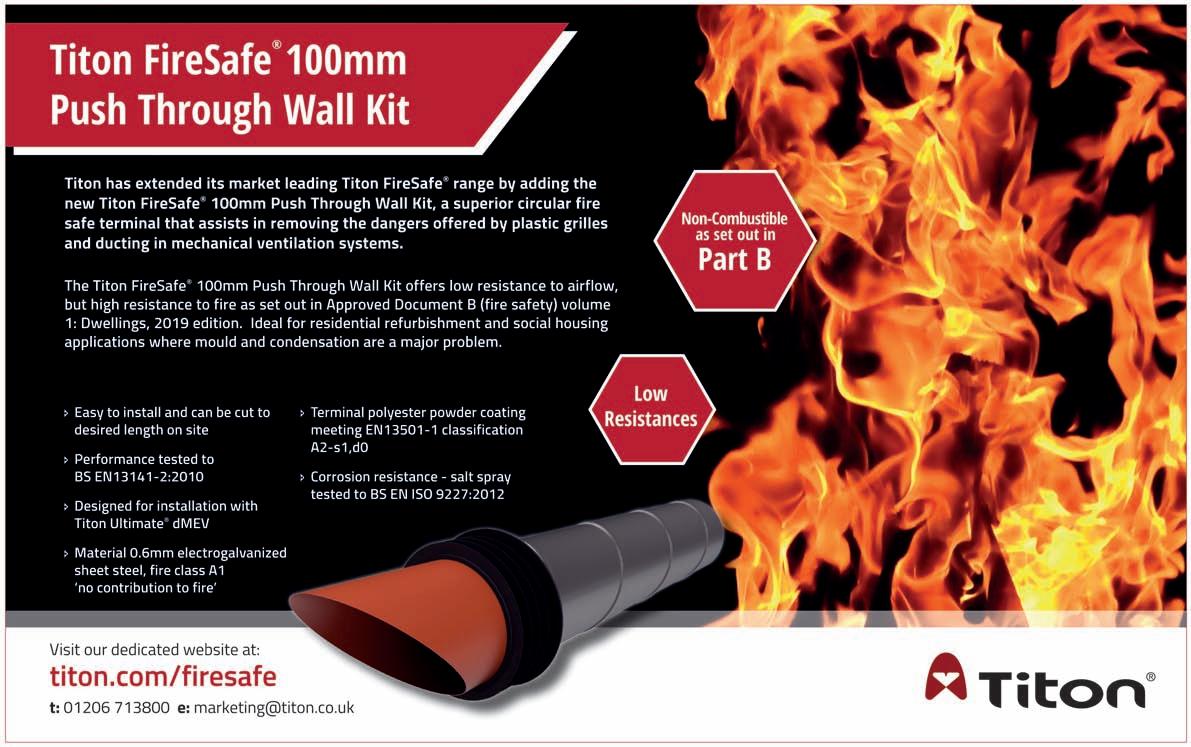
www.hamag.co.uk APRIL 2023 21
The challenges for a renewable ASHP future
George Clarke discusses how we encourage the uptake of more heat pumps
I’ve previously written about the ‘Challenges’ for a renewable air-source heat pump (ASHP) future for UK homeowners, and now I’d like to focus on housebuilders, developers, landlords and commercial property owners.
Let’s start with private landlords.
Currently there is no legislation to force private landlords to replace their old, existing gas boilers with a renewable energy heating system.
Just over 4.4 million households live in privately rented homes in England, the equivalent of 19 per cent of all households.
When you think about it, that is a massive amount of housing stock.
The boiler upgrade scheme exists to try and ‘encourage’ landlords to make the switch to airsource heat pumps by 2035, but they can currently keep working gas boilers past this date.

If we are serious about a zero-carbon future then this absolutely has to change, but its not a straightforward transition at all.
Many rental properties (particularly apartments) just don’t have the outside space for the ASHP unit to be installed. Also, far too many rental properties are poorly insulated with too many draughts to the
point that an ASHP may struggle to heat the home properly. This huge issue has to be tackled first.
Unfortunately, the government are a million miles away from addressing this problem.
There is a ‘DECENT HOMES STANDARD’ for the Social Rented sector, but at the moment there is no Decent Homes Standard for the private rented sector.
One idea would be to have an national ‘Home Building Fabric Upgrade Scheme’ (that actually works and that isn’t burdened by red-tape!) backed by strong ‘Home Improvement Legislation for All Existing Homes’, while coming up with innovative solutions with industry on how to provide lowcarbon (ideally zero-carbon) heating to existing flats and apartments.
n Shared
networks
HEATING NETWORKS and SHARED HEATING SYSTEMS need to be developed for apartment blocks, so individual gas boilers can be removed from each apartment and replaced with a green and sustainable communal heating system.
The government are looking to change this and have recently gone out to consultation on the issue, but with 21% of Private Rental Sector homes being classified as ‘non-decent’ and 12% being classified as ‘Housing Health and Safety Rating Category 1’ (which represents a “serious and immediate risk to a person’s health and safety”) then this massive problem has to be tackled and fast. (Figures recently published by the English Housing Survey).
It is frankly ridiculous for the government to make grand announcements on a zero-carbon future, but not act quickly and decisively on some of the poor conditions in our private rental housing stock.
Unfortunately, when it comes to upgrading the country’s existing housing stock the wheels of government are far too slow and are taking far too long to work out the right direction to travel and that is just not good enough.
It is a fact that the home-building and home-retrofit industry is reluctant to significant change, so tougher legislation is needed if the government has any chance of hitting its own zero-carbon targets.
How we balance tougher legislation for better quality, energy efficient rental properties with increased material and construction costs, high inflation as well as the lack of a large-scale, highlyskilled workforce to efficiently eco-retrofit existing
n HEATING, ENERGY EFFICIENCY, VENTILATION, CONDENSATION & MOULD CONTROL 22 APRIL 2023 www.hamag.co.uk
“Unfortunately, when it comes to upgrading the country’s existing housing stock the wheels of government are far too slow and are taking far too long to work out the right direction to travel...”
Image © Adobe Stock
buildings is a massive challenge for government and the industry.
But, we cannot shy away from it.
n The end of gas
We’ve discussed in previous articles that the government has banned gas heating for all new build homes from 2025, although I do find it headshakingly ridiculous that they chose not to ban gas hobs for cooking in new-build homes at the same time.
Maybe this will come about naturally when gas boilers for heating are banned. But, there are absolutely no plans to phase out gas boilers in existing homes, which for me, is nuts.
Also, there is no requirement for property developers who refurbish existing homes or convert existing buildings into homes to move away from using gas boilers to more ecological and sustainable forms of heating.
Surely, if any existing homes are being developed and refurbished by property developers to the current building regulations, then there should be a statutory requirement from them to move away from gasboilers!
Retro-fitting our existing buildings to be low or zero carbon is one of the biggest challenges the UK faces.
There is also some evidence to suggest that very welldesigned, green buildings have a very positive effect on the happiness and wellbeing of staff.
Greener buildings, low-running costs and a happier workforce is surely a win, win, win situation.
n Adopting a long-term view
Established organisations who build their own commercial buildings for them to occupy for many years are definitely taking a long-term approach to making the ‘home’ of their employees more ecological.
They see the long-term value in the investment they are making to make their buildings green.
n Green commercial spaces
With commercial buildings things are actually looking more positive.
There is a growing demand from companies who want the commercial spaces they rent to be more green and energy efficient.
There are ESG (Environmental, Social, Governance) related factors where many companies now have very strong corporate environmental values and are willing to pay for it.
Many corporate organisations (the ones who can afford it!) are often happy to pay a rental premium to have their workforce in greener buildings.
One building that springs to mind is the New York Times HQ designed by Renzo Piano and completed in 2007. The intelligent building managements system and innovative technologies adopted (such as the responsive lighting systems) means the building when built was 70% more efficient than New York’s building codes, saving the company millions of dollars in annual running costs.
But, a company building its own ‘home’ is similar to a family ‘self-building’ their own domestic home.
Owner/occupiers in both commercial or residential self-build projects often go way beyond the building regulations and are willing to invest far more in their ‘homes’ to be green.
The challenge is to convince landlords to do the same.
n Raising the EPC standard
A commercial landlord who owns a commercial building to rent out to a tenant is now coming under pressure to make their building more ecological.
A new report by commercial real estate agent, Colliers, claims that around 10% of London’s office space has an EPC rating of ‘F’ or ‘G’ making it potentially unusable and un-rentable when new MEES (Minimum Energy Efficiency Standards) come into effect this year.
The report also states that there is a genuine appetite from tenants for sympathetically refurbished buildings that benefit from low carbon technologies and energy management tools.
Tenants are genuinely willing to pay higher rents if they know their energy running costs are being significantly reduced.

Commercial office space landlords should be seeing the ecological retrofit of their buildings as being a fantastic opportunity to create more demand and more income, rather than being a burden.
On all fronts Government, industry, property developers, private landlords and commercial landlords need to be working closely together to create a zero-carbon future.
George Clarke is an Architect, writer, TV presenter and Ecodan Ambassador
This article and other blog’s by George Clarke appear regularly on Mitsubishi Electric’s The Hub, visit les.mitsubishielectric.co.uk/the-hub

www.hamag.co.uk APRIL 2023 23
“...there is a genuine appetite from tenants for sympathetically refurbished buildings that benefit from low carbon technologies and energy management tools.”
Image © Adobe Stock
TV’s George Clarke Image © Mitsubishi Electric
VORTICE launches Positive Input Ventilation System to the UK market




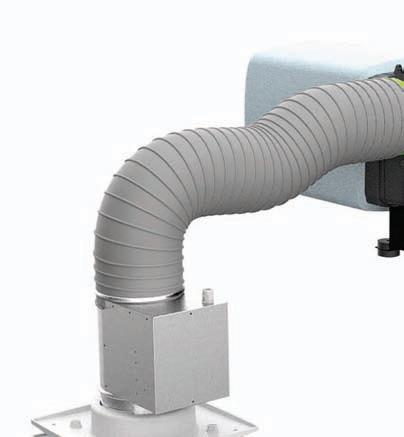
VORTICE has launched a new Positive Input Ventilation System (PIV) in both loft and wall versions to help eradicate the issue of mould in the home. We spend more than 90% of our time indoors and unless we take steps to ventilate our homes correctly, the quality of the air we breathe can be 50 times more polluted than outdoor air, with all the associated health risks. Why is that? We are sealing up our homes and when you contemplate the number of cleaning products, hair sprays, paints, air fresheners, new furniture and carpets that we bring into our home, you’ll realise what we’re feeding into our indoor air. One of the main issues is the rise of humidity, encouraging the presence of condensation, mould and dust mites in the home and if not treated properly can cause or increase health risks such as breathing issues or skin allergies.
air introduced to the property when the weather requires it. The unit boasts many features for the installer such as a data logger, easy to control panel and pre-set and lockable functions for quick and easy set up. VORTICE prides itself on the stylish Italian design that is evident in this product, ensuring that products are not only ergonomic, functional and eco-friendly but also aesthetically pleasing.
Positive Input Ventilation (PIV) means that a loft unit continuously draws air through the loft’s natural leakage and ventilation points from outside, then feeds it through a filter into the property via a central hallway diffuser. The wall unit works in the same way but is directly ducted to the outside and situated in the hallway of the property. By bringing this fresh air in, it reduces the humidity in the home, reducing the opportunity for mould to grow.
The main benefit of the VORTICE system for the occupant is the air distribution box accessory; this allows the air to be distributed evenly in the home, reducing the requirement for a heater. The unit is equipped with seasonal settings which allows a heater to be used to increase the temperature of the
“The main benefit of the VORTICE system for the occupant is the air distribution box accessory; this allows the air to be distributed evenly in the home, reducing the requirement for a heater.”
Marketing Manager Jennifer Quinn says: “Recent news headlines have demonstrated the problems to health that mould brings, something we have been discussing for a long time. We are delighted to bring such a fundamental product solution into the VORTICE range in order to tackle this vital issue and it is brilliant for the market.”
For further information on the Vort PIV range or to learn more about mould and condensation in the home, please visit the dedicated page on our website www.vortice.ltd.uk/vort-piv-range

Images © Vortice
LG success for new Therma V Monobloc ‘S’ heat pump

The announcement from the UK Government that it would provide a £5,000 grant from April 2022 to individuals choosing to install a heat pump over existing fossil fuel driven heating systems was the next crucial step towards major uptake of proven heat pump technology in preference to reliance on gas, oil and solid fuel options for domestic heating and hot water provision in the UK. The recent announcement that this level of support will be extended into 2028 will help even more people to switch from traditional boiler driven systems to renewable heating and hot water. The Future Homes Standard requires serious action and quickly if targets are to be met. Renewables and higher standards of building quality in, for example, recognition of better standards of insulation in homes are key to meeting the aims of the FHS.Heat pumps have a major part to play.
Hydronic components like the improved plate heat exchanger, the expansion tank, water pump, flow sensor, pressure sensor, air vent valve and safety valve are all built in - inside the outdoor unit – pre-installed and ready to run. And the R32 Monobloc ‘S’ provides excellent heating performance especially at low ambient temperatures whilst lowering its carbon emissions even more with the use of R32.
This new unit sees built in water flow and pressure sensors to monitor the water circuit in real time, advanced water pump control, enhanced second circuit logic, energy monitoring of estimated power consumption via the remote controller, MODBUS connectivity without Gateway if required and advanced control for the domestic hot water recirculation pump.
The original version was extremely quiet, but this new ‘S’ version is even quieter and up to 9kW units can be installed at the minimum of 4 metres away, and up to 16kW units - up to 5 metres away from neighbouring houses complying with
international noise regulations. The heat pump has been awarded the Quiet Mark in the last couple of months highlighting the Therma V Monobloc S as one of the quietest heat pump options available.
The unit comes with a Seasonal Coefficient of Performance of up to 4.67 (Average climate/Low temperature application) and a A+++ rating. The COP rises to 4.9 (Outdoor air 7°C/Leaving water temperature 35°C) and can deliver leaving water temperature of 65°C if required.
For more information on the new LG Therma V Monobloc ‘S’ head for partner.lge.com/uk, or email LG at uk.aircon@lge.com


24 APRIL 2023 www.hamag.co.uk n HEATING, ENERGY EFFICIENCY, VENTILATION, CONDENSATION & MOULD CONTROL
Image © LG
LG’s ASHP new build design service warmly welcomed

Leading HVAC manufacturer LG has recently launched a New Build Design Service, to assist new build developers including social housing developers when specifying heat pumps into new homes. In the short time it has been in place, it has already been welcomed by new build developers taking advantage of the new service.
This new service is for developments of 6 or more plots and will provide full designs for plumbing and heating layouts along with equipment schedules that specify the heat pump required, radiator or underfloor manifold heating positions, pipework type and length and controls to ensure that the system which is specified will provide the necessary heating and hot water solution for any house archetype. Furthermore, LG also offers a unique service for CFD (Computational Fluid Dynamics) analysis, determining the optimal location and performance simulation of the outdoor units. Contact LG to find out more about the new service and to get details of how LG can help you in the months ahead.
LG: b2bmkt.lge.com/newhousebuilders • peter.spurway@lge.com
Advice on heating savings for social housing providers - from ESi…
Question: With rising utility prices, energy efficiency is on everyone’s minds. How can the latest Smart Controls help deliver energy savings?
With many heating controls being controlled from apps on smart phones and tablets, the ability to control your heating at any time of day and from virtually anywhere means you can be in more control than when you are at home. Modern controls allow you to control several heating zones in the home and control these individually and more accurately so you can easily increase the temperature in the rooms you will use as you head home after work, for example. And you can monitor the temperature levels in different parts of the home, reducing temperatures in rooms that will not be used but leaving enough background heat to keep them comfortable.

With energy prices increasing its important to take a close look at every way in which energy can be saved and costs kept to a minimum and this is why ESi controls are OpenTherm compatible. The way OpenTherm works allows far smoother transition of heating control, which reduces energy and saves money. Using OpenTherm will save between 10 and 15% on the gas bill. We will see increased awareness of OpenTherm controls in the next few months as people begin to realise the savings these controls offer when connected to a modern condensing gas boiler.
ESI CONTROLS: www.esicontrols.co.uk
Vent-Axia celebrates Global Recycling Day and improves indoor air sustainably
Vent-Axia celebrated Global Recycling Day, which took place on 18 March 2023, by showing its commitment to expanding its range of recycled plastic ventilation products and meeting its environmental targets. Vent-Axia is leading the way in the ventilation sector with a market transformation to manufacturing from recycled material to improve indoor air sustainably. This includes its award-winning Lo-Carbon Multivent MEV range which literally broke the mould as the first MEV to be made from recycled plastic. This has now expanded to a wide range of products including its Positive Input Ventilation (PIV) units and Mixed Flow In-Line fans, helping customers in a wider range of sectors make more sustainable choices.
The company is committed to reducing its environmental impact by setting and meeting key targets: by the end of FY2025, over 70% of its products will be from one of its Lo-Carbon™ ranges and 90% of the products that it manufactures will be made from a recycled source. By manufacturing ventilation units from recycled plastic through open loop recycling, Vent-Axia is using a sustainable source of raw material; there is a reduction in the embodied carbon; it reduces plastic going to landfill; avoids the consumption of oil stocks; consumes less energy than producing new virgin polymers; and follows sustainable values reducing human environmental impact. Using recycled plastic is a true innovation. Vent-Axia has previously reduced its single-use plastic waste and produced ducting from recycled plastic. Vent-Axia’s market-leading Multivent MEV range is now manufactured from a reliable, regularly available, recycled source of ABS plastic. This marks an industry step-change in ventilation manufacture, allowing Vent-Axia to produce the range in recycled plastic without affecting the unit’s function or performance. To find out more about Global Recycling Day visit: www.globalrecyclingday.com
VENT-AXIA: www.vent-axia.com

Titon extends popular Titon Firesafe® range
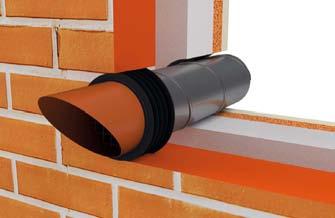
Titon has extended the market leading Titon FireSafe® range by introducing the new non-combustible Titon FireSafe® 100mm Push Through Pull Kit that is ideal for Social Housing, new build, and refurb residential applications.
The Titon FireSafe® 100mm Push Through Pull Kit is a fire rated terminal and ducting kit that has been designed specifically for applications that need to meet be non-combustible, as set out in Approved Document B (fire safety) Volume 1: Dwellings, 2019 edition.
Titon FireSafe® 100mm Push Through Pull Kit is performance tested to BS EN13141-2:2010 and corrosion salt sprayed BS EN ISO 9227:2012. Constructed from 0.6mm electrogalvanized sheet steel (A1) and polyester powder coated (terminal only) to classification A2-s1, d0.
The Titon FireSafe® 100mm Push Through Pull Kit has been developed to work with Titon’s energy efficient constant flow Titon Ultimate® dMEV, which has been tested in accordance with the latest SAP10 dMEV (Consp10) test standard introduced on 15th June 2022. The Titon FireSafe® 100mm Push Through Pull Kit is also compatible with the vast majority of 100mm fans on the market.
The new Titon FireSafe® 100mm Push Through Pull Kit is easy to install and cut down to a desired length, it’s perfect for onsite installation when current systems need to be changed or new ones need to be installed.
Speaking about the introduction Roy Byom, Titon’s Social Housing Manager stated, “This product will enable installers with achieving a fire rated through the wall duct application, from ground floor to properties at higher levels.”
The new product comes in Terracotta and White, with special paint finishes available on request, depending on the quantity required.
TITON: www.titon.com/uk
www.hamag.co.uk APRIL 2023 25
Image © LG
Image © Vent-Axia
Image © Titon
Image © ESi
Are carbon reduction plans in social housing stuck in a rut?
Housing associations have a pivotal part to play in supporting the UK’s journey to net-zero but further change is needed if we’re going to get there.
The UK has some of the most energy leaking housing in Europe, much of it built in the pre-war period.
According to the National Housing Federation the UK’s 29million homes produce 58.5million tonnes of CO2 every year. That’s more than the CO2 produced annually by all car journeys.
It also makes up round 14% of the UK’s emissions and with a commitment to cut total UK emissions by 80% relative to 1990 levels by 2050 under the Climate Change Act (2008), that’s a big problem for Government.
With around 2.7million homes across England, on their books, housing association owned and managed properties account for one of the single biggest ‘slice’ of emissions, creating an opportunity for big wins in the fight against climate change.
“Get the road map right for carbon reduction in housing association-owned properties, and the UK can take a big step forward in reducing CO2 emissions from homes in a single sweep”, explains John Duckworth, Director of Commercial Sales, Deceuninck.

“A more effective approach to the building fabric has the potential to significantly lower energy consumption in new and existing properties through retrofit.
“The challenge is that right now, that road map isn’t entirely clear, and funding remains, and is likely to remain, a pressure point, so housing associations and their supply partners need to innovate to get where it’s universally agreed, that we need to go.”
“Get the road map right for carbon reduction in housing association-owned properties, and the UK can take a big step forward in reducing CO2 emissions from homes in a single sweep...”
To get across the 2050 carbon neutral finishing line, those 2.7million homes will need to achieve an Energy Performance Certificate C rating or above. This at present appears some way off, with more than 60% of social properties in England and 44% of social homes in Wales, falling below the EPC standard.
New build social homes fair better, but top A-rated properties still only account for fewer than 1.2% - just 607 – of the 50,000 new social housing properties completed in the UK last year.
“The Government has pledged £3.8bn to the Social Housing Decarbonisation Fund, to try and address the deficit in energy performance in existing properties through retrofit.
“It’s also said in the autumn statement that it would make a further £6billion of new funding available from 2025 to 2028 for energy efficiency.
“It isn’t, however, only about funding - but also strategy. How can a more effective approach to the building fabric be developed to meet the UK’s climate change ambitions, both in terms of retrofit –but also new build social housing.”
n The impact on window and door specification
As a key element of the building envelope and a potential major source of CO2 (according to Government figures, 18% of heat loss occurs through windows), windows and doors are a key element of the building fabric.
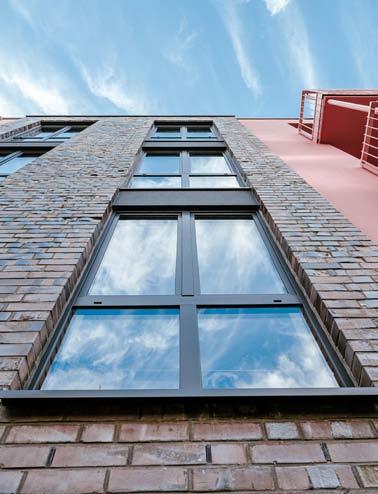

26 APRIL 2023 www.hamag.co.uk n DOORS, WINDOWS, ACCESS & SECURITY: Cover Story
John Duckworth, Director of Commercial Sales, Deceuninck.
Above and right: Elegant, Deceuninck’s new energy efficient fiberglass composite window system.
This was recognized in the changes to Part L that we saw last year which introduced a new requirement of 1.2W/m2K for new build windows and doors with a glazed area of more than 60%; and 1.4W/m2K for replacement windows and doors.
“The changes that we saw last year, are in fact just the start of what will be a series of performance changes for windows and doors in the coming two-to three years, with consultation on future changes to Part L, and under the Future Homes Strategy, imminent”, continues John.
“This could see u-values for new build reduced to as low as 0.8W/m2K, or more likely 0.9W/m2K. Even at the latter, housing associations and their supply chains, are going to have to re-think window and door specification because products as they sit today, aren’t going to deliver required performance.”
n Triple-glazing
U-values of 0.9W/m2K immediately push window and door specifications into triple-glazing but John argues that the ramifications are broader.
“A lot of older aluminium systems are simply going to fall short but even for far more thermally efficient PVC-U options, there are also challenges”, John says.
“That’s why Deceuninck is developing a new generation of products which use less carbon in manufacture but which also deliver higher levels of thermal efficiency and reduce carbon, through life.”
n Elegant - next generation window performance
This includes Elegant, Deceuninck’s new energy efficient fiberglass composite window system redefines expectations of performance including U-values as low as 0.8W/m2K. This goes far beyond current building regulations, future proofing its offer to the specification sector.
It’s defined by contemporary minimalist features, creating a strong architectural aesthetic which replicates aluminium in an advanced, low maintenance and energy efficient, composite system.
John continues: “Elegant, our award winning, new ultra-energy-efficient window and door offer sits within our wider sustainability strategy.
“It’s a next generation window system which has been designed to deliver exceptional through life performance, while also being designed to be easier and use less energy to recycle at end-of-life”, he explains.
n Working to in partnership to support housing associations to lower their carbon footprint This focus on sustainability continues through to Deceuninck’s commitment to ambitious targets to reduce greenhouse emissions through the corporate carbon reduction scheme, Science Based Targets (SBTi).
This includes a commitment to cut the CO2 emissions from its own operations (Scope 1&2) by 60% by 2030 from a 2021 baseline. Allowing for future growth in real terms this means reducing CO2 per tonne of product produced by 75%. This goes significantly beyond the SBTi minimum target of 42%.
It has also committed to cut emissions from within its supply chain (Scope 3 emissions) by 48% per tonne by 2030, as part of its wider journey to netzero greenhouse gas emissions by 2050.
As part of this strategy Deceuninck has invested more than €15million in one of the world’s most advanced recycling and compounding facilities to create the capacity to reprocess up to 45,000 tonnes of post-consumer and post-manufacturing PVC-U per year.
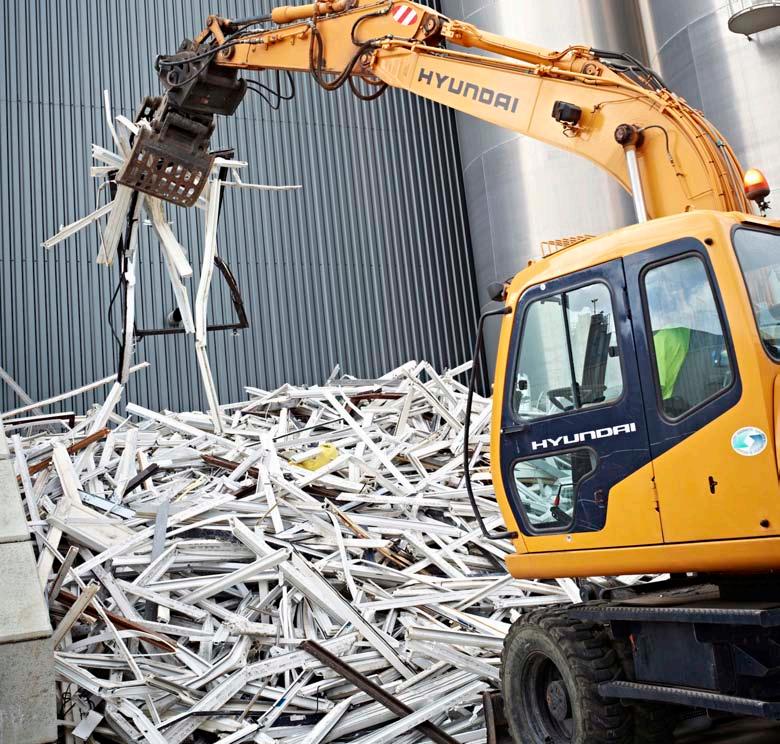
In real terms this gives it the capacity to prevent more than three million windows from going to landfill annually.
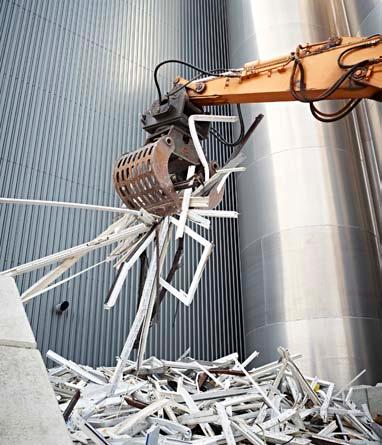
“The window and door industry is committed to rising to the challenge. Deceuninck for one, is committed to developing low carbon manufacturing technologies and a new generation of products which deliver big through-life energy efficiency gains”, John explains.
“Big changes, do however, need to be made if we’re going to get to net zero. That’s going to require a re-think about the way in which new build and replacement windows are specified by housing associations and main contractors.”
For more information about Deceuninck’s product and service offer please call 01249 816 969, email deceuninck.ltd@deceuninck.com or visit www.deceuninck.co.uk
www.hamag.co.uk APRIL 2023 27
“...Deceuninck is developing a new generation of products which use less carbon in manufacture but which also deliver higher levels of thermal efficiency and reduce carbon, through life.”
Above and right: Deceuninck has invested more than €15million in one of the world’s most advanced recycling and compounding facilities.
Images © Deceuninck
Reduce lifetime costs with aluminium
Housing associations looking to modernise their building stock should consider upgrading doors and windows with aluminium systems. Andrew Cross, Marketing Manager of Kestrel Aluminium Systems, explains why.

New windows and doors could be a real benefit to housing associations looking at their next schedule of upgrade works, thanks to the energy efficiency and lower lifetime maintenance costs they offer. There are tens of thousands of housing association properties across the UK still fitted with old, tired windows and doors. Some may have single-glazed windows with old, wooden frames, while others may be double glazed, but with the original double-glazed panes that have long since been surpassed by the features of modern glazing and aluminium systems.
Removing these old windows and replacing them with modern, aluminium alternatives can help to greatly reduce heat losses in a building thanks to their enhanced thermal insulation. Today’s aluminium systems are manufactured with thermal break technology to prevent the expansion and contraction of window seals causing issues that were once prevalent in early double-glazing products. This helps keep tenants warmer and makes it easier for them to turn their thermostats down and reduce energy costs – something that many desperately need to help them better manage their bills during these high cost-of-living times.
One of the most important benefits of modern, aluminium windows and doors for housing associations is just how low maintenance these systems are when compared to more traditional materials. Wooden frames need regular cleaning, then sanding and re-painting every 5-8 years to keep them in good condition. This can be a significant time and financial commitment for housing associations when they have to carry out this maintenance process on potentially hundreds or thousands of properties in their portfolio.
This maintenance programme can be made even more difficult if the maintenance teams struggle to contact tenants to arrange a suitable time for these works to be carried out, or if tenants do not want to have tradespeople entering their homes.
In comparison, aluminium doors and windows need no sanding, painting or maintenance outside of a routine cleaning regime, which can save housing associations significant amounts of money, time and aggravation over the 45-year lifetime of the window, while keeping the home looking as good as new for decades.
“Aluminium is incredibly strong, as well as being lightweight and extremely malleable.”
Another feature of aluminium is its protective oxide coating, which makes it naturally corrosion resistant, durable and damage resistant – both while being installed and once in use. Some manufacturers, such as Kestrel Aluminium Systems, also offer a range of surface treatments including powder and anodised coatings, that can be added during manufacture to further improve the product’s overall strength.
“One of the most important benefits of modern, aluminium windows and doors for housing associations is just how low maintenance these systems are when compared to more traditional materials.”
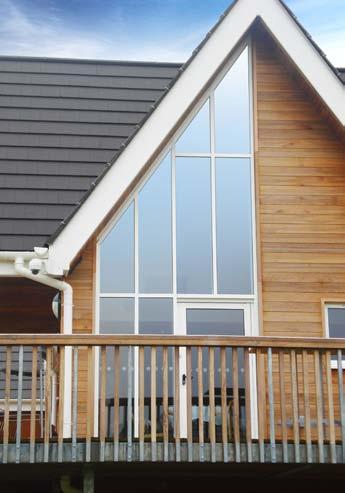
Most of Kestrel’s aluminium sections are stocked in mill and white powder-coated finishes, and we also have our own powder-coating facility in operation at our factory, which means our customers can request a wide range of standard RAL colours to suit any décor or building style. These can then be delivered to site with industry leading turnaround times of just five working days, ensuring that any building works can be completed on time with no complicated delays.
Aluminium window and door frames also offer enhanced security features for tenants. Aluminium is incredibly strong, as well as being lightweight and extremely malleable. This high strength-to-weight ratio means the systems can be very slim, making it possible to design large aluminium doors and windows with very narrow frames. Not only does this maximise the light and view that comes in through the window or door, it also improves the security of the finished product, as it is more resistant to damage or ingress and helps improve the security of the home for tenants.
Kestrel’s aluminium window and door systems have been supporting UK installers and fabricators for more than 30 years. The company offers excellent customer service and high-quality, reliable products that to allow projects to be completed on time and to a high standard.
For more information on Kestrel’s systems, visit www.kestrelaluminium.co.uk or call 0121 333 3575.
28 APRIL 2023 www.hamag.co.uk n DOORS, WINDOWS, ACCESS & SECURITY
Images © Kestrel

It’s time to down tools & hotfoot it to FIT Show
We get it, you’ve got a backlog of leads to fulfil and your order book is looking pretty healthy for the foreseeable. You’re probably thinking there’s not much point in taking time off the tools to make a trip to FIT Show (NEC 23 - 25 May, 2023.) It’s only been a year since the last FIT Show, so there won’t be much new to see, and you can always go next year, right…? WRONG!
News Flash! After FIT Show this May, our tenth anniversary edition no less, FIT Show won’t return until May 2025. Can you afford to leave three years between your FIT Show visits by not attending this May? This is your chance to secure your future pipeline and drive long-term leads.

And if you think there won’t be anything new to see, you couldn’t be more wrong. Over 25% of the lineup is made of brands who have never exhibited before, and 40% are from overseas. These are brands and products that you will never have seen at FIT Show before. In the last few weeks alone brands such as Sheerline (Garnalex), Whitesales, Supalite, Gerda Doors by Pioneer Trading, Saint-Gobain, Listers, Glazerite, Business Micros, Chekatrade, Mennie Canada. Emmegi and Deponti have joined the lineup (And there are even more BIG names still to be announced!) Expect to see 200 brands showcasing thousands of the latest products.
Alongside new brands, you won’t want to miss the brand new Installer HUB feature with live product demos where you will be able to receive training and support on how to install the latest products on the market, as well as speak directly to the people who manufacture them.
Have you heard about our CPD Certified learning programme? We’ve teamed up with GGF & FENSA to curate a programme of 30+ hours of seminars, all delivered by industry experts. You will be able to attend free sessions like these:
• ‘Facing the future: 2023 State of the Nation’
• ‘How to avoid a race to the bottom’ (working for sales, selling more high margin products, wider themes)
• ‘Market trends and expectations’
• Building Regs – ‘Future Homes Standards’ & ‘The Building Safety Bill’
• U-values and net zero goals - ‘Meeting the demand for the 100,000,000 windows which need replacing’
• ‘Get social media fit; five easy ways to find and secure sales using social media’
• ‘How to use storytelling to increase sales’

• ‘Fire Doorsets: Legislation Changes’
• ‘Regulation changes in roof lights and lanterns’
• ‘Sustainable Glazing - the future of recycled glass’
• ‘Pulse Testing - An alternative to trickle vents?’
You can view the full programme and register for these sessions via www.fitshow.co.uk/seminars.
You’ll be able to combine work and pleasure at FIT Show this May, with a mountain of exclusive show offers and discounts to take advantage of.
• FIX Radio will be broadcasting live from the show and there will be competitions running when you’re on site.
• Winkhaus will be offering up Virgin Experience Day vouchers as part of their on stand promotion.
• Two visitors to ODL Europe’s stand will win £500 of holiday vouchers each.
Exhibitors will be offering genuine discounts on products and services that are exclusive to FIT Show - these are offers that you can only access if you attend this May.

Party Time! Did we mention, it’s our ten year anniversary event this May? Join us as we celebrate ten years of FIT Show and a decade of being the UK’s number one trade show for the window, door, glass, hardware and components industry. To save you time off the tools, we’ll be opening late on Wednesday 24th May (10am to 8pm) so you can always join us after work. And it wouldn’t be a late night at FIT Show without the PiG’s Party which is promising a BIG extravaganza with live music and an extra place to network after you’ve seen all of the latest products on the market.
There has never been a more important time to plan a trip to FIT. What are you waiting for? Down tools immediately and head to fitshow-2023.reg.buzz/ door-industry-journal to register for your FREE ticket!
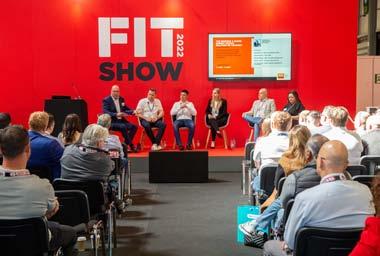
30 APRIL 2023 www.hamag.co.uk n DOORS, WINDOWS, ACCESS & SECURITY
Images © Fit Show / Montgomery Group
“And if you think there won’t be anything new to see, you couldn’t be more wrong. Over 25% of the lineup is made of brands who have never exhibited before, and 40% are from overseas...”
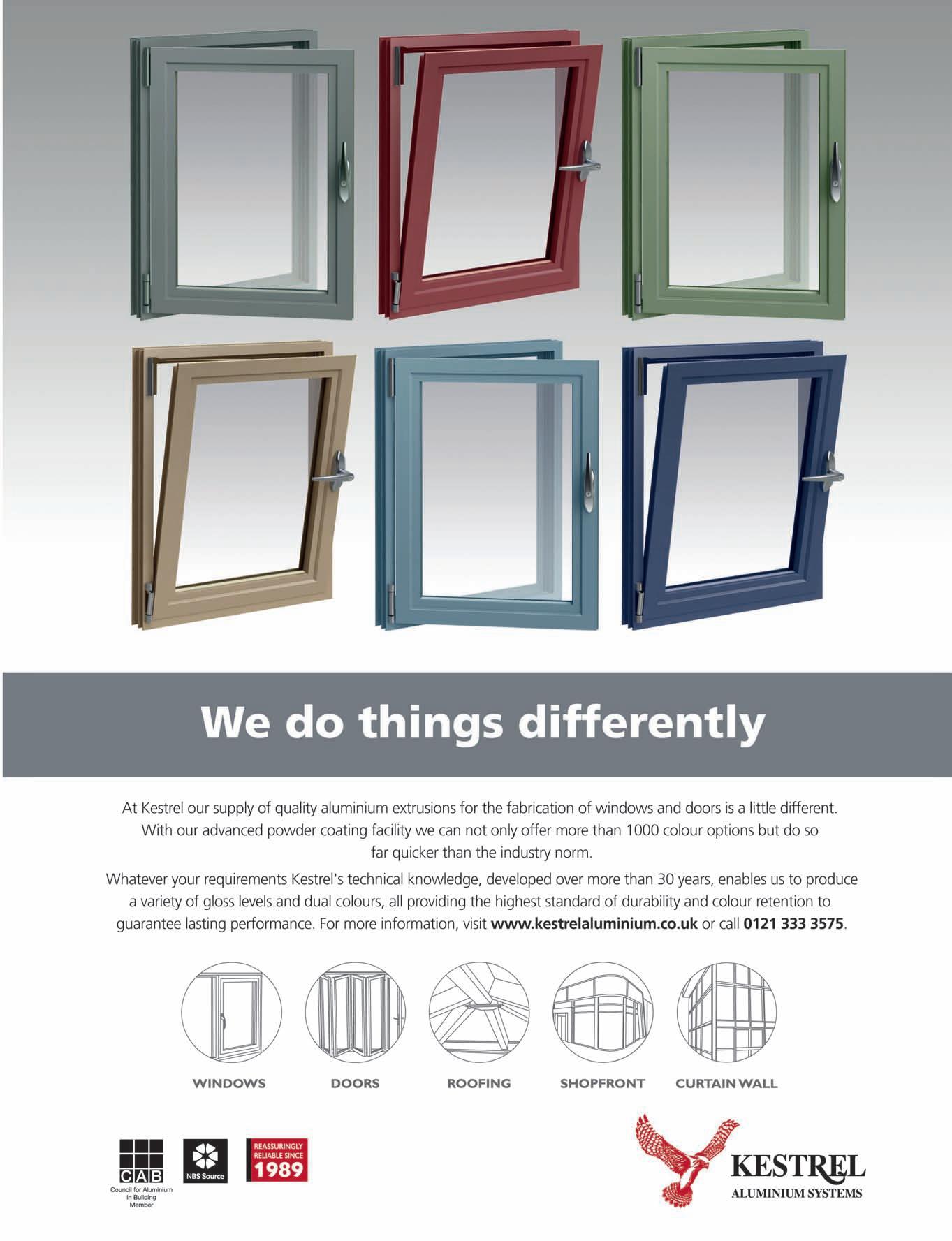
Shelforce receives royal seal of excellence with King’s Award for Enterprise
Birmingham-based window and door manufacturer Shelforce has been recognised with the highest official UK award for British business, The King’s Award for Enterprise in Promoting Opportunity (through social mobility).

Established in 1965, the awards have propelled UK businesses onto the world stage with an internationally-renowned symbol of excellence. Previously named The Queen’s Award for Enterprise, His Majesty The King has approved the Prime Minister’s recommendation that Shelforce be recognised.
Shelforce employs 30 people, of which 75% have a disability, and provides a place where people with mental or physical disability can thrive in employment and produce high quality products in a competitive market.
Howard Trotter, the company’s Business Manager, will represent the company at a royal reception hosted by His Majesty The King at Buckingham Palace.
“It is an unbelievable honour to receive the King’s Award for Enterprise in the Promoting Opportunity category,” comments Howard. “To be recognised by the highest honour in UK business, renowned across the world is an incredibly proud moment for Shelforce.
“Promoting opportunity is the reason behind Shelforce’s continued success and this is fantastic recognition for our incredible team and the processes we have in place. It’s also fantastic news for the local community of Erdington.”
Specialising in high-quality PVCu and aluminium products to housing associations and local authority building projects, including Birmingham City Council, Shelforce’s recent success has been down in no small part to the launch of its fully compliant Fireshel 30-minure fire, smoke and security resistant door.

“To be able to fly the King’s Awards flag and use the emblem is amazing and we are hoping it will help open the door to other councils and housing associations, whose social values and sense of social responsibility line up with our own.”
For more information, telephone Shelforce on 0121 603 5262 or alternatively visit www.shelforce.com
Fastener choices require critical focus in fire doors
Housing specifiers should pay particular attention to the fasteners used in the manufacture and installation of their proposed fire doors to prevent them become weaknesses that undermine the doorset’s performance, according to window and door fastener specialist Rapierstar
Whilst any deviation from the product specification or best practice for installation is not recommended, there is always scope for product substitutions and incorrect application to occur. Hence why double checking the fasteners in fire doors is an important best practice step to prevent potentially catastrophic consequences.

Superior quality fixings by Rapierstar their retain strength in the attachment throughout the service life of a door, thereby reducing the risk of door elements becoming loose. This helps prevent a vulnerable point developing over time, which can lead to the door failing to protect lives and assets as per the fire test should it ever be required to do so.
This is why Rapierstar fasteners are used by leading fire door manufacturers, including those using the Q-Mark certified FireFrame solution from Winkhaus. This delivers doorsets with a 30 or 60-minute rating, plus smoke resistance and enhanced security to the Secured by Design standard.
RAPIERSTAR: www.rapierstar.com
Respected fire door system now certified for external use, fanlights and sidelights
Hurst Doors has become one of just a handful of UK suppliers certified to produce a quality composite FD30s fire doorset with sidelights and fanlights.
The company are now certified under the BM Trada UKCA marking of external pedestrian fire rated doorsets scheme. This allows them to supply five of their most popular door styles for settings that are open to the elements, such as external flat entrances, incorporating fanlights and/or sidelights.
Subjected to rigorous third party testing, the Neuma fds fire door system has undergone more than 30 bi-directional tests at three independent and accredited European test laboratories.
In testing the fire doors achieved an average integrity of 45 minutes (or 50% longer than the FD30s standard requires). Suitable for reactive maintenance, refurbishment projects, new-build developments and more, Hurst’s fire doors are currently being supplied to several large-scale social housing projects.
Mart Atkinson, Hurst Doors Sales Director comments: “The Neuma fds fire door system was born out of a desire to create a fire door product that was proven to consistently perform and that the sector can rely on.
“That meant we needed it to offer outstanding fire performance – but also be versatile enough to excel in a wide variety of residential and commercial settings.”
The product has also been tested to the tougher EN 1634-1:2014 standard. Testing has been completed on both solid and glazed door options.
In addition, all stages of the Neuma fds supply chain are third party certified to the BM Trada Q-Mark certification scheme.
HURST DOORS: www.hurstdoors.co.uk
32 APRIL 2023 www.hamag.co.uk n DOORS, WINDOWS, ACCESS & SECURITY
“Promoting opportunity is the reason behind Shelforce’s continued success and this is fantastic recognition for our incredible team and the processes we have in place.”
Image © Shelforce
Image © Joe Gough - stock.adobe.com
Image © Rapierstar
Leading the way: Sentry Doors unveil new look Knowles
Sentry Doors are never content to stand still. As the UK’s leading manufacturer of timber fire safety and security doors, they’re constantly innovating and improving their product range to ensure that they meet customer needs whilst remaining at the very forefront of the industry.
Sentry Doors’ recent acquisition of E. & S. W. Knowles Company Ltd is a case in point. The extensive Knowles product range now sits within the Sentry Doors catalogue of market-leading products, giving customers access to a complete range of fully certified fire doors, which are suitable for all markets.
Following the acquisition, Sentry Doors is pleased to announce the launch of a new look Knowles range, which sits perfectly within the Sentry family and reflects both brands shared vision for the future.
As a result of the brand transformation, E. & S. W. Knowles Company Ltd will now simply be known as Knowles.

The new branding uses familiar elements of the Sentry logo and encases them around the Knowles range. This cradling effect is symbolic of the safety and protection that the company has built its reputation on.
n Largest UK fire door manufacturer
The newly expanded business continues to be headquartered in Doncaster, where Sentry Doors has an additional 40,000 sq. ft facility. This takes the company’s total footprint to 100,000 sq. ft across the Birmingham and Doncaster branches, both of which are fully equipped with the latest manufacturing equipment.
n Known and trusted for over 130 years
The transformation of the brand also coincides with Knowles’ centenary year. This major milestone means that they now have over 130 years’ collective experience in manufacturing specialist doorsets.
n Bespoke, sector specific solutions
As part of Sentry Doors, production of the Knowles range will take place at the 60,000 sq. ft facility in Birmingham, where the focus will be on manufacturing specialist timber internal doorsets with fire rated, acoustic and PAS 24 security certification. The 100-strong team in Birmingham offers bespoke, sector specific solutions that meet the exacting requirements of its commercial, healthcare, education and leisure customers.

The acquisition added many new, complementary products to Sentry Doors’ already well-established range of fully certified bespoke timber fire and security door sets, designed for the social housing, public sector, commercial and residential markets.
Sentry Doors’ reputation for quality and certification is what makes them a UK leader, and now that they can cater to all markets, the organisation is able to provide an even wider, bespoke range of products.
Sentry Doors also benefit from having all the skills and capabilities required to manufacture their products inhouse, and since the acquisition, they have invested £1.2m to support the expansion of production capabilities in Birmingham. This gives the organisation complete quality control at every stage of production and demonstrates that they are truly a centre of excellence and expertise. It also enables them to offer a complete, end-to-end service, consistent lead and delivery times and a first-class customer experience.
n Made in Britain
The expansion has provided Sentry Doors with the opportunity to pursue further innovation and growth, whilst maintaining their ongoing commitment to being the UK leader in timber fire and security doorsets, at the forefront of compliance and regulation. Sentry’s products are tested and certified to the highest industry standards, giving customers complete confidence and peace of mind.
In addition, Sentry Doors are proud to have obtained the official ‘Made in Britain’ stamp. As the only official, protected mark which certifies that a product is made in Britain, the mark gives confidence to customers that Sentry is a trusted and transparent manufacturer.
Sentry prides themselves on their unique approach, which seamlessly blends traditional, timehonoured techniques with modern manufacturing methods. While Sentry are rightly proud of their combined history, heritage and reputation, this brand transformation and expansion provide an opportunity for them to look to the future.
Ty Aziz, Sentry’s Chief Executive, said: “Together, Sentry Doors and Knowles have an incredible manufacturing heritage, while our complementary products and skills make us a formidable company. We’re very happy to be marking this acquisition with a new look and a logo that reflects our shared vision and goals, while cementing our status as a known and trusted brand.
“The rebrand marks a key milestone in the growth strategy for our businesses and advances our ambition to be UK leaders in this sector.”
For easy installation and compliance, you can be secure with Sentry.
enquiries@sentrydoors.co.uk, 01302 337 473 sentrydoors.co.uk
www.hamag.co.uk APRIL 2023 33
“Together, Sentry Doors and Knowles have an incredible manufacturing heritage, while our complementary products and skills make us a formidable company.”
Image © Sentry Doors
Risk free with single source
Stuart Nicholson, Roof Systems Director at Marley, says that working with a single source roofing manufacturer, who understands the Part L regulations changes, can help mitigate risk in a changing regulatory landscape.
Changes to Part L of the Building Regulations have been implemented so that new homes produce 31% lower carbon emissions. It is the precursor to 2025’s Future Homes Standard (FHS) which will demand that new homes are specified and constructed to be energy efficient, use low carbon heating solutions, and be zero carbon ready.
Against this changing landscape, housing associations looking to deliver a proactive strategy of housing refurbishment, retrofit upgrades or capital investment, need to be mindful of their ongoing responsibilities. It is also important the supply chain they use provides reassurance and easy access to the range of solutions needed to meet energy efficiency, safety and performance standards.
n Renewable solutions
High performing and sustainable roofing solutions can make a real contribution to creating sustainable homes and ensure compliance with Part L regulations.
This is because improvement in energy efficiency (and lower carbon emissions) cannot simply be delivered by enhancing the building fabric solely. In the short term, solar PV on the roofscape, combined with an efficient gas boiler, appears to be one of the easiest and most cost-effective ways for housing associations to meet the Part L carbon reduction targets.
PV technology is tried and tested, readily available and has become much more affordable in recent times. For housing associations, the latest integrated PV roof systems, such as Marley SolarTile®, offer a more visually appealing, cost effective, and easier to install option. Replacing a section of roof tiles, integrated solutions provide a sleek aesthetic and function as a seamless part of the overall roof.
“For ultimate peace of mind, housing associations should seek to specify a fully evaluated complete roof system. Marley’s full roof system includes JB Red battens, underlay, tiles or slates, fixings, accessories, SolarTile® and the newly launched ArcBox solar enclosure.”

n Safety first with ArcBox
To support the integrated solar panel roof offering, Marley has further expanded its SolarTile® offering with the launch of its solar connector enclosure, ArcBox.

While the risk of an electrical fire caused by solar PV is extremely low, nonetheless safety must be a primary concern. ArcBox has been designed to further enhance safety standards across all types of solar installations.
Independently verified by the KIWA fire test laboratory and Loughborough University, ArcBox is part of Marley’s comprehensive full roof system, underpinned by a 15-year guarantee. It is suitable for solar projects in both domestic and commercial settings such as schools, hospitals or care homes and building-integrated photovoltaics (BIPV) solar projects, or any building where DC cabling must be installed in the vicinity of roofing made of combustible materials.
Renewable technology solar PV systems are here to stay. They will be a critical component leading the transformation of buildings and homes into more sustainable energy efficient and low carbon places in which to live, work and connect.
n Single source strategy
Part L and FHS are regulatory reality checks for housing associations looking to create the type of homes needed, as well as satisfying the legislative requirement to remain compliant with the new emission targets going forward.
For ultimate peace of mind, housing associations should seek to specify a fully evaluated complete roof system. Marley’s full roof system includes JB Red battens, underlay, tiles or slates, fixings, accessories, SolarTile® and the newly launched ArcBox solar enclosure.
The full roof system is backed by a 15-year warranty and ensures every roof is fully compatible with all current regulations, including fire safety, and reduces the risk of inferior product substitution that can compromise roof performance.
By selecting a fully integrated roofing system from a single source; one that includes a high performing solar PV solution and safety components such as ArcBox, housing association can be they are supporting strong sustainability outcomes and proven safety assurance at the same time. www.marley.co.uk
34 APRIL 2023 www.hamag.co.uk n EXTERIOR BUILDING ENVELOPE
Marley’s SolarTile®
Marley’s solar connector enclosure, ArcBox
Images © Marley

Apprentice Bricklayers from Hull College visit Crest for an open day event
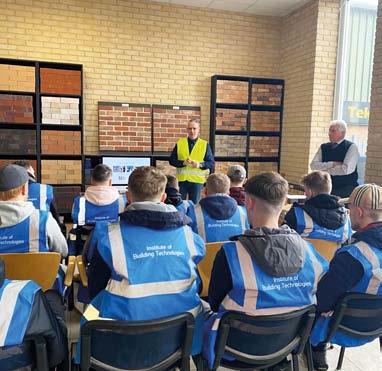
Crest has been working in conjunction with Hull College, supplying clay-facing bricks for the students to work with on their apprenticeship courses. The Crest team arranged an open day aimed to provide the students with an insight into the industry and an understanding of the products we supply.
The event was opened by Crest’s Managing Director Stuart King who welcomed the students to Crest, and discussed his own career journey within the industry, this was followed with a presentation by Crest’s Marketing Manager Neil Mace who talked them through a history of Crest, an overview of the products Crest supplies, and an insight into our European manufacturing operation. He also discussed the various house-building projects that Crest is involved in across the region.
After the opening presentation, the 12 students were divided into 3 groups, and further presentations were provided by Sales Director Paul Lawson, Area Sales Manager Tony Askew and Marketing Manager Neil Mace.
Paul Lawson discussed with the students site practice, troubleshooting, dimensions and tolerances, Tony Askew introduced the students to the Crest range and gave them an understanding of various special products including Crests Linea Long Format bricks, Neil Mace gave a tour of the Crest warehouse, and provided information on the shrink wrap process, packing procedures and brick sample operation.
The students visited the Crest showroom which gave them the opportunity to look at the many brick displays within the showroom, the brick displays showed the students the various mortar colours and how they can affect the facing brick appearance.


Lunch was provided and after lunch, the students and tutors had the opportunity to discuss the days events with the Crest team and ask any questions that they had. One of the students had phone images that he had taken of an outbuilding within his garden and asked the Crest team for advice on matching with a brick from the Crest range.
Course tutor Shaun Stephens thanked everyone involved in the day and for the warm welcome received by the Crest team and for sharing the information provided and said: “We feel the day was a great success for both the tutors and apprentices and everyone took something away with them and enjoyed the experience”.
Shaun extended an invitation to the Crest staff to visit the College and offered a free wall within the College for Crests advertising purposes.
After the days events feed back was received by course tutor Shaun Stephens, who had asked the students for their thoughts on the visit and what they had learnt from the experience. The event received a positive review and some of the comments received from the students are listed:
• Gained a good understanding on how bricks are made.
• I found it interesting and would of liked the activities to go on longer.
• Learnt a lot about Crest and how we depend on each other.
• Learnt how bricks are made and the different types.
• Good information on Crest and brick types
• Fun and informative.
• Learnt how different components are used to make bricks.
• Different kind of experience to college enjoyed learning how bricks are made.
• Learnt a lot about the manufacturing process and how to test brick tolerances.
• Really helpful to see what happens to bricks before they get on-site.
The Crest team are delighted that the day was a success and feel privileged to be helping in shaping the industry’s future brick-laying generations. Crest looks forward to continuing their working partnership with the College.
www.crest-bst.co.uk
36 APRIL 2023 www.hamag.co.uk n EXTERIOR BUILDING ENVELOPE
n Crest’s sales director Paul Lawson explains brick dimensions and tolerances to the students.
n Crest open day working in partnership with Hull College Students.
n Crest’s Tony Askew shows the 1st year students the different brick types.
Images © Crest

The Colt Service training centre: taking smoke control maintenance seriously
If you own or manage a building, you will know that the proper maintenance and testing of life safety systems such as smoke control is extremely important and should not be taken lightly. That is why we demand only the highest standards from our service and maintenance engineers. It is also why we are proud to announce that at the end of 2022, we opened our brand new Colt Service Training Centre at our manufacturing plant in Havant.
This state-of-the-art facility enables us to provide the very extensive and smoke control-specific training that our engineers require and that we were unable to find externally.
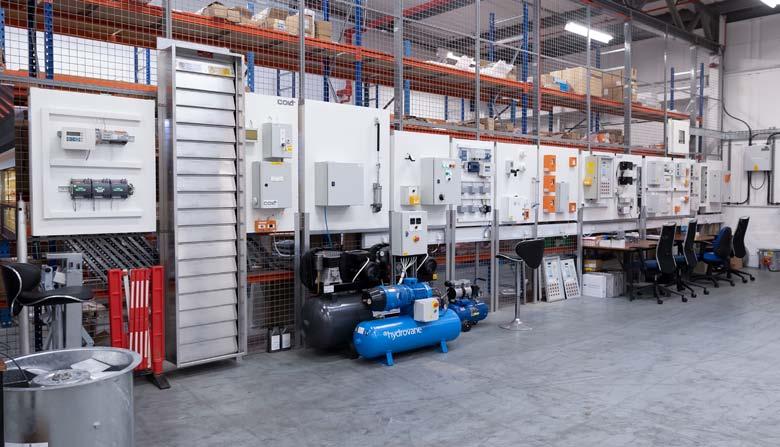
Designed specifically for the initial and ongoing training of our maintenance engineers, the centre is equipped with working examples of all the types of smoke control systems our engineers would encounter in the real world. This includes Colt-produced systems, but also those of other manufacturers. By receiving this extensive training, our engineers are confident that they can provide the very best service, regardless of who manufactured your system.
At the centre, our highly experienced technical managers deliver initial and ongoing training to our engineers. The training is not only in system maintenance, but also in regulatory updates and standards as well as fault-finding to enable firstfix works wherever possible. This means that our engineers are competent, knowledgeable and always able to advise you on every aspect of your system’s

upkeep. As regulations frequently change, having up to date information from a trusted supplier can be invaluable in helping you keep your buildings safe and legal. It can also help to avoid fines or other costly mitigation measures such as perhaps needing to employ a waking watch if system maintenance is not found to be up to standard.
Training is regularly updated and our technical managers are continually monitoring the skill levels of our service engineers through a series of assessments in order to allocate training where its most needed. Only once an engineer has been fully trained up and tested to our high standards will they be allocated sites to attend, supervised in the first instance.
n An investment in knowledge always pays the best interest.
At Colt, we recognise the importance of proper smoke control maintenance and believe that the training of our engineers is never complete – we are always looking to ensure that they are the very best at what they do. With a Colt engineer, you can rest assured that your systems are in safe hands.


To learn more about the benefits of a Colt service contract, scan the QR code.

If you would like to organise a free site survey with one of our engineers, email us at service@ uk.coltinfo.co.uk or call us on 02392 491735.
www.coltinfo.co.uk
n FIRE PROTECTION & TENANT SAFETY 38 APRIL 2023 www.hamag.co.uk
Author Tom Archer, Colt UK Sales Manager.
Images © Colt International

Creating safer, healthier and more sustainable homes with IoT technology
The use of Internet of Things (IoT) technology within the housing sector is rising with housing providers across the UK rapidly deploying connected devices within their properties to improve housing quality and asset management, while promoting resident health and wellbeing.
Aico’s HomeLINK Connected Home Solution includes a network of fire and carbon monoxide (CO) alarms, as well as environmental sensors for measuring temperature, humidity and carbon dioxide (CO2) to assess a property’s indoor environmental conditions.
These devices connect to a central Gateway in each property, giving landlords a full overview of property and stock-level deployment information. The data from these devices, surfaced on the HomeLINK Portal, presents actionable insights, enabling landlords to meet their responsibility of providing safe and healthy homes.


With HomeLINK, it is possible to streamline processes through actionable insights into challenges such as damp and mould, energy efficiency, indoor air quality, compliance and more.
n Retrofit monitoring and evaluation for PAS 2035 Environmental sensors can assist with decarbonising properties, highlighting poor performing homes in regard to energy efficiency.
Pre-Retrofit Monitoring: Target properties that need improving the most, for the biggest impact first. Environmental monitoring provides a greater understanding of which properties require what retrofit solution, from draught and ventilation issues to heating and cooling performance.
Post-Retrofit Monitoring: As the UK’s existing housing stock varies considerably in age and condition, a one-size-fits-all approach to retrofit could potentially lead to unintended consequences within some properties e.g. increased airtightness can increase the risk of damp and mould. Tracking retrofit measures enables landlords to assess the impact of installed measures across archetypes and other building and resident characteristics to inform future retrofit strategies, leading to targeted results and optimised investment.
n All in one Fire and CO Protection
n Save time and cost with preventative maintenance
The actionable insights enable landlords to be proactive rather than reactive. From identifying an environmental risk – for example, poor indoor air quality, a risk of mould or bad ventilation – to knowing if there are maintenance issues like an alarm head removal from the baseplate. By leveraging data and insights, landlords can target in-need properties and effectively allocate resources to generate both time and cost savings.
n Empower residents to take control of their home's indoor environment
n Mould Prevention: Identify properties with a risk of damp and mould
Aico’s HomeLINK Environmental Sensors provide an alternative to impractical and outdated temperature and humidity data loggers, collecting all the data necessary for powerful algorithms to calculate if a property has the ideal conditions for mould to grow.
The recently released ‘super insight’ enables landlords to dig deeper, providing a precise indication of whether the cause is environmental or structural. It can indicate whether there is something that needs to be addressed in the fabric of the home or if the environmental conditions that the property is subject to need to be altered.
The HomeLINK Portal enables a clear insight into fire and CO alarm system performance to improve resident safety, reporting on:
• Fire activations
• CO alarm activations
• Background CO levels
• Alarm head removals from baseplate
• Test button activations
• Alarm age
• Alarm replacement dates
This information allows landlords to comply with legislation whilst improving asset management through accurate forecasting of alarm maintenance and replacement.
The HomeLINK App educates residents on how to avoid poor environmental conditions, reducing callouts and preventing issues from beginning or deteriorating. Using their own data, the app will warn residents when conditions are not optimal within their homes, providing guidance on how to remedy issues, why taking action is important or what could happen if they didn’t act.
The App provides the opportunity to enhance resident-landlord relationships, and plays a key role in combatting issues such as fuel poverty, damp and mould, fire risk and more.
The entire solution, from hardware to software, is built from the ground up with privacy, safety and accuracy in mind to make services more efficient and cost-effective. To find out more, visit: www.aico.co.uk/homelink
Images © Aico
40 APRIL 2023 www.hamag.co.uk n FIRE PROTECTION & TENANT SAFETY
Aico’s Environmental Sensor
Aico’s HomeLINK portal
“The entire solution, from hardware to software, is built from the ground up with privacy, safety and accuracy in mind to make services more efficient and cost-effective.”

Aico host webinar on A Spotlight on Damp and Mould with The Housing Ombudsman


Aico has recently welcomed the Housing Ombudsman Service to an online event focusing on damp and mould in the housing sector and best practices to keep residents safe.
“A Spotlight on Damp and Mould: It’s not lifestyle” report, published in October 2021 placed the responsibility for resolving poor quality housing in the hands of social landlords. The report provided 26 recommendations for landlords to assess their approach to resolving cases of damp and mould. In February 2023, The Housing Ombudsman published a follow up report to provide insight into landlords’ responses to the 2021 report. This new report included a number of actions that landlords have taken as a result, including improving surveying equipment, the use of sensor technology, resident facing apps and the use of an online dashboard, such as the HomeLINK Connected Solution.
Following the reports, HomeLINK’s Sustainability & Ethics Lead, Sam Collier, welcomed Victoria King, Sector Learning and Development Lead for the Housing Ombudsman Service and Mark England, Head of Innovation, Sustainability and Procurement for Coastline Housing. The panel also welcomed Alan Park, Compliance and Systemic Investigations Manager at the Housing Ombudsman Service for an engaging and thought-provoking Q and A session.
With over 500 attendees, Sam Collier opened the event giving an overview and timeline of the increased efforts to prevent damp and mould cases by the sector as a whole and highlighted the work yet to be done. Victoria King presented on the “It’s not lifestyle” report one year on, highlighting a need for a change in culture and The Housing Ombudsman’s recommendations. Victoria was followed by Mark England, who shared Coastline Housings approach to the report, highlighting the use of data and a proactive approach.
To watch this full webinar on demand, please subscribe to Aico TV here: www.youtube.com/@aico-tv
Firefly’s Titan Lite selected to protect Lewisham roof spaces

AICO: www.aico.co.uk
Fully compatible products from the range of TBA FIREFLYTM have been chosen to compartmentalise roof voids between apartments and communal lobbies of a large apartment building in the London Borough of Lewisham, providing 120 minutes fire integrity protection as part of a wide ranging refurbishment programme carried out earlier this year. The contract on Lewisham Homes’ Commodore Court in Albyn Road has been led by the sector specialist construction company, Mulalley & Co. with London/Sevenoaks based CLM Fireproofing carrying out the installation of the TITAN LiteTM 120:60 barrier system, in combination with Collaroll and the use of ancillary products from the FIREFLYTM range. TITAN LiteTM 120:60 has been developed for use in vertical separation or compartmentation situations, offering 120 minutes integrity and 60 minutes insulation and is able to be sealed around penetrations. It is widely specified to form fire barriers within roof voids and floor voids in many different property types, including tower blocks and other HMOs.
The flexible woven material is easy to cut and fix, and is chemically treated to improve its cooling properties and therefore prevent temperatures rising in adjoining areas. The system has been fully tested to BS 476 Parts 20 & 22 and is third party certified by IFC. The six metre long rolls of TITAN LiteTM 120:60 have a minimum thickness of 6mm and are installed using special staples as well as high temperature adhesive. Employed as part of the FIREFLYTM System and also to wrap the services which penetrate barriers such as PHOENIX, ZEUS LiteTM and APOLLO LiteTM, Collaroll comes in a roll which unwraps to 10m long x 300mm wide with a sewn in concertinaed skirt. The skirt can be moulded to shape to seal it neatly to the upright barrier, which is usually at 90 degrees to the Collaroll and fixed into place using the FIREFLYTM high temperature adhesive. The R31 Staple Gun and Staples are used to staple the Collaroll to itself tightly around the penetration.
TBA FIREFLY: www.tbafirefly.com
ROCKWOOL® launches new CPD to support fire stopping stakeholders
ROCKWOOL has launched a new CPD ‘Fire Stopping – Understanding your liability’, to educate fire stopping stakeholders on how to manage liability through improved proficiency and best practice adoption. The one-hour session is available to book online at rockwool.com/uk and is offered as an in-person CPD.
‘Fire Stopping – Understanding your liability’ is the latest CPD in a fire protection education series, explaining current UK Acts and statutory regulations and how they influence your legal liability in provision of fire protection.
Underpinning the company’s CPD programme is an extensive suite of technical and support tools to facilitate quality and accurate installations. This includes the Firestopping Standard Details Guide which equips architects, developers and contractors with detailed drawings on approved applications for the FIREPRO® firestopping range. Also at hand is the ROCKWOOL FIREPRO® Resource Hub. This online hub helps specifiers to select the most suitable passive fire protection solutions for their projects, with an array of product information, performance advice and technical tools.
To learn more about the ‘Understanding your liability’ module, register to attend the CPD session at rockwool.link/HA-CPDL
ROCKWOOL: rockwool.com/uk
Aico invites their supply chain to build a safer future together
Aico has recently hosted four events to explore how their supply chain can work collaboratively to build safer futures for residents of the UK, welcoming 400 industry professionals to their headquarters in Oswestry.

To support their mission statement of promoting best practice and delivering safer homes, Aico invited customers from all areas of their supply chain to these ground-breaking events, including electrical contractors, distributors and registered social landlords.
Held throughout February and March, the events combined insights and evidence into how connected homes can create safer and healthier properties for all, from improving fire safety to reducing the risk of poor indoor environmental conditions, such as damp and mould and poor indoor air quality.
Members of Aico’s expert team delivered a range of engaging and impactful workshops to drive a synergistic approach to building safer futures.
AICO: www.aico.co.uk
42 APRIL 2023 www.hamag.co.uk
n FIRE PROTECTION & TENANT SAFETY
Image © Aico
Image © Aico
Image © Rockwool
Image © J. Ward Turner Publicity Ltd

Reducing water and energy usage with shower specification
Sustainability is on the tip of everyone’s tongues. The knock-on effect for housing associations is that there is an expectation from buyers that new homes will be intrinsically ‘green’ through their design. Martyn Brown, Contracts & Technical Manager at Triton Showers, explores how shower specification can assist in creating eco and energy friendly homes.
Triton recently conducted a survey of 2,000 consumers to explore the changes in showering habits caused by the cost-of-living crisis. It found that 53 per cent have changed the way they shower in a bid to reduce household bills. Interestingly, 69 per cent were already conscious of the impact of their bathing habits on energy consumption before the effects of inflation were seen.
When looking to be more sustainable, water habits really do make a difference. Whether that’s reducing time spent in the shower or providing transparency around product energy usage, everybody has a part to play. Housing providers can help kick-start homeowners’ green living practices by specifying eco-friendly products, like electric showers.
n Every drop from an electric shower makes a difference
It’s clear that occupants want to conserve water, so there’s a need to specify products that can help reduce this usage. By choosing electric shower models, like Triton’s Amore range, housing providers can play their part in bringing both water and energy consumption down significantly saving residents money.
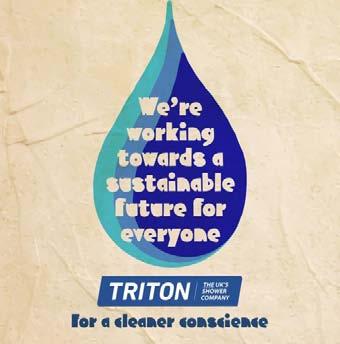
Drawing on domestic cold mains supplies and heating water on demand, an electric shower can provide homeowners with a more energy efficient solution. This is supported by Triton’s own research, which found that opting for an electric shower, rather than a mixer model can save residents up to 52,000 litres of water and knock up to £208 off a three-person household’s annual bill – all while providing the convenience of hot water on demand.
Housing providers can go one step further by looking for models that are registered under the BMA (Bathroom Manufacturers Association) water efficiency scheme, such as Triton’s eco models. The certification informs consumers that labelled products are recognised as significantly water efficient and operating in line with the government’s plans to reduce personal water consumption by 23%, from 143 to 110 litres per day, by 2050.
n Trading up to see energy use come down
Alongside water savings, in Triton’s latest research, for example, it found using an electric shower cost nearly a third less than a mixer shower and can reduce carbon footprint by 70%. The findings were based a five-minute shower and compare an 8.5 kW electric model to a mixer fed by an A-rated combi boiler outputting 12 l/min, with the analysis also showing users can reduce energy usage by 76% and save just over 40 litres of water. Specifying an electric model
means water is only heated when it is needed, which increases efficiency, reducing energy usage and household bills.
Triton’s survey also found that 64% are unsure how to monitor their own usage. This is where housing providers can help educate residents by using tools like Triton’s Energy and Water Savings Calculator. The calculator asks simple questions about household occupants and typical showering habits, before providing personalised tips and suggestions for improvement.
On top of this, electric showers have come a long way in design and functionality making it easier than ever to incorporate the appliance into a desired bathroom look. An example is Triton’s Amore DuElec™, which is available in striking matt black or white and chrome finishes. The new innovation offers spa-style showering with a fixed overhead rainfall shower, alongside a handheld fivepattern spray head.
n Ripe for change
Recent economic factors and a sustainable consumer focus have proven that now is as good a time as any for housing associations to go electric with their shower specification, especially given the proven efficiency benefits of the latest electric showers. Housing providers are perfectly positioned to move towards these options through considered specification and if done at scale, can make a huge contribution to a more sustainable showering future while reducing homeowner bills in the process.
For more about Triton Showers and its range of electric showers, please visit www.tritonshowers.co.uk/showers-taps/electric-showers
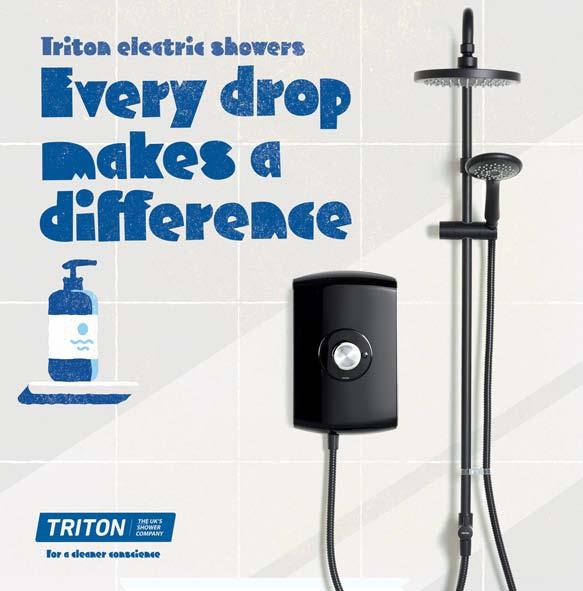
44 APRIL 2023 www.hamag.co.uk
Images © Triton
n KITCHENS,
“...now is as good a time as any for housing associations to go electric with their shower specification, especially given the proven efficiency benefits of the latest electric showers.”
BATHROOMS, INTERIORS & INCLUSIVE DESIGN
Stelrad launches compact 900mm high radiators


As part of its programme of providing radiators to operate well with renewable heating systems – powered by air source and ground source heat pumps - Stelrad has announced that it will be launching a range of 900mm high radiators in a variety of widths in quarter 2 2023. Head of Marketing Chris Harvey said: “There is a clear need for larger size radiators to cope with the lower circulating system temperatures generated by renewable heating systems and we are making sure our installer and specifier customers have access to the full range of options they will need in the months ahead.
“The arrival of the new upgrade to Building Regulations with effect from 15th June in England and from November this year in Wales brings with it a realisation that the key figure to bear in mind is 55°C – the maximum flow temperature for all new wet heating systems from this date. The regulations also say that heating appliances and radiators should not be oversized. TRVs need to be fitted to every radiator except where there is a room thermostat fitted. The differential between the flow and return should be 10°C – giving a 45°C return, and a mean water temperature of 50°C. This will have an impact on radiators but simply means that sizing of radiators is more important than ever and all the advice you could need is available through relevant websites to point installers and specifiers in the right direction with regard to using the right radiators in the right applications.
“The transition from fossil fuelled, boiler driven systems to heat pump driven renewable systems is well underway and we’re making sure that installers and specifiers realise fully that radiators are ‘fit for the future’ and more than capable of providing the necessary heat around the home – radiators need to be sized properly as always to provide sufficient heating capacity and insulation needs to be evaluated to ensure its adequate to ensure the heat in the home does not escape to atmosphere.”
Head for www.stelrad.com for all the advice you need to decide on the right radiators for your installations and heating system designs.
Amtico introduces new Click Smart flooring designs
Amtico has refreshed its popular Click Smart luxury vinyl tile (LVT) collection.
The loose lay, rigid core LVT features a robust locking mechanism that allows individual planks and tiles to be easily clicked together without the need for adhesive. The new Parquet option provides specifiers with even more design flexibility. Made with up to 20% recycled pre-consumer content, the flooring is less susceptible to indentation and movement, perfect for catering to the unique demands of the build-to-rent (BTR) and purpose-built student accommodation (PBSA) sectors.
The integrated underlay and robust locking mechanism also assist with quick and easy installation, while the 20dB impact sound reduction meets building regulations and is ideal for highdensity living spaces where noise reduction is crucial.
The new range of Click Smart products benefits from the same performance features as Amtico’s core LVT collections, including a 0.55mm wear layer and urethane coating. They are also 100% waterproof to ensure the planks and tiles won’t absorb water or swell/expand.
AMTICO: www.amtico.com/commercial
www.hamag.co.uk APRIL 2023 45
Image © Stelrad
STELRAD: www.stelrad.com
Titon delivers the ultimate package


Titon are pleased to announce that they now offer the ultimate ventilation package for bathrooms and kitchens. By combining the Titon Ultimate® dMEV fan with the new Titon FireSafe® 100mm Push Through Wall Kit terminal, it’s the perfect combination to help fight condensation and mould.
Ideal for refurbishment or new build, the unique offering meets stringent building regulations Part F and B and can be utlised with the new dMEV auraSMART app.
The high performing Titon Ultimate® dMEV is an ultra-quiet low profile fan. It has a one fan fits all solution and is ideal for bathrooms, kitchens and utility room applications. With adjustable continuous and boost speed settings available, the Titon Ultimate® dMEV utilises an efficient DC motor and incorporates a uniquely designed impeller/guide vane combination to produce high flow rates and pressure.
The social housing version is the perfect solution for landlords who want to make sure that mould and condensation are not a constant problem. The Titon Ultimate® dMEV is easy to maintain, simple to monitor using its unique relative humidity data logging facility and can be commissioned in minutes.
The new dMEV auraSMART app will connect to your ventilation system to provide monitoring, control and user-friendly operation and system commissioning.
Helping maintain an indoor air quality for a healthy home environment

via its data logging facility, the Titon Ultimate® dMEV has exceptionally low specific fan power down to 0.11 W/l/s and offers outstanding sounds levels of 10 dB(A), whilst meeting stringent newly proposed 20 Pa back pressure requirements.
Available in three versions; standard, humidity and humidity control with data logging, the Titon Ultimate® dMEV is perfect at fighting condensation and mould issues within a home.

The new Titon FireSafe® 100mm Push Through Wall Kit is a circular high flow terminal designed for powered ventilation systems offering low resistance to airflow, but high resistance to fire as set out in Approved Document B (fire safety) volume 1: Dwellings, 2019 edition.
Ideal for new build, refurbishment and social housing residential applications, it is constructed from sheet steel (A1) and polyester powder coated to classification A2-s1, d0.
Titon FireSafe® 100mm Push Through Wall Kit is designed to be installed from the inside of the dwelling and will create a seal to the external all. The range consists of a Ø100 round version at 630mm long.

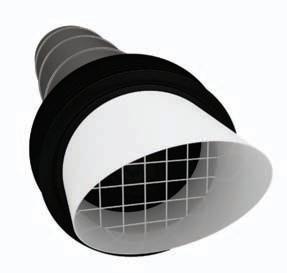
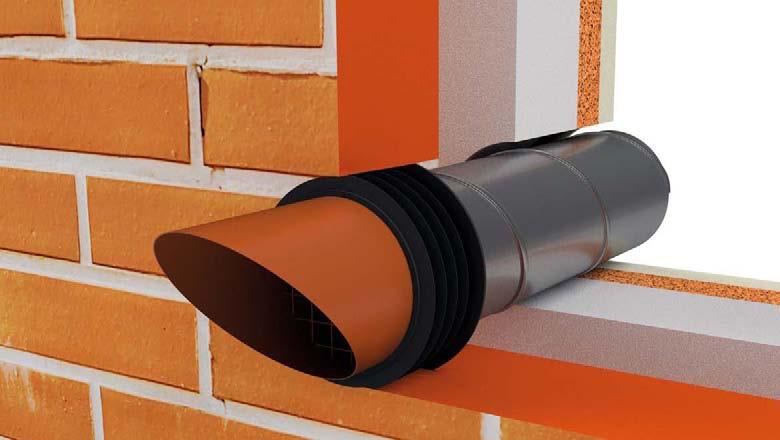
Roy Byom – Titon’s Social Housing Manager stated; “The development of the Titon Ultimate® dMEV was a result of listening to our customers’ requirements and needs, the addition of the Titon FireSafe® 100mm Push Through Wall Kit, a fire-rated throughthe-wall duct and the dMEV auraSMART app to allow control over wi-fi, a unique function in the market place at the moment is an example of how Titon can respond to market requirements and create a one stop solution ideal for any application.”
www.titon.com/uk
Images © Titon
n KITCHENS, BATHROOMS, INTERIORS & INCLUSIVE DESIGN 46 APRIL 2023 www.hamag.co.uk
Titon’s FireSafe® Round Air Brick Installation through wall
Above & left: Titon’s Ultimate dMEV fan commissioning.
Left: The Titon FireSafe® in white
“The development of the Titon Ultimate® dMEV was a result of listening to our customers’ requirements and needs...”

Altro explores inclusive design with neurodiversity focus for Clerkenwell



Visit Altro’s showroom during Clerkenwell Design Week to be immersed in a journey of discovery about design for neurodiversity. By exploring how people experience spaces differently, expert panel discussions, talks and practical workshops, Altro will share best practice on how to design spaces for everyone.
Around 35% of the UK population is thought to be neurodiverse, meaning that their brain functions, learns and processes information differently. Altro has been championing the importance of designing spaces to be inclusive through its forum events for specifiers and end-users, and its recent ‘Designing for Neurodiversity’ CPD. Altro’s showroom programme for Clerkenwell Design Week draws and expands on this knowledge and experience. Across the three-day programme, Altro will facilitate talks and discussions with leading experts in the field. Professor Anastasios Maragiannis, award-winning Professor of Inclusive Design at the University of Greenwich, London, will lead a panel discussion.
For those looking for hands-on activities, Altro’s CDW programme includes virtual reality experiences to explore how people experience spaces differently and drop-in mood board workshops looking at how materials help create an inclusive built environment. Make Altro an essential part of your Clerkenwell Design Week - visit the showroom at 15 Clerkenwell Green from 9am, 23rd to 25th May.
Forbo’s integrated flooring helps to refurbish flexible workspace
Forbo Flooring Systems’ contemporary range of floor coverings were specified by Momentum, a leading furniture expert based in Cardiff, to create a warm and vibrant hybrid working space for Newydd Housing Association. Forbo’s Tessera carpet tiles, Allura Luxury Vinyl Tiles, Coral entrance flooring system and Surestep safety flooring were all used. Momentum designed the whole refurbishment and specified all the materials.
Forbo’s Tessera Chroma and Cloudscape carpet tiles made up the majority of the flooring space across the three-floor office building.
Tessera Chroma has a 26 dB sound reduction, making it perfect for the meeting room pods that are connected side-byside, stopping noise from distracting those outside or next door. Furthermore, Forbo’s Allura LVT was specified across the refurbishment and was laid in a Herringbone pattern. Forbo’s Allura LVT was also used in the Mist Texture colourway for the ground floor entranceway. With its R10 slip rating, ensuring staff stay safe whilst using the onsite facilities, Forbo’s Surestep safety flooring was also specified for the ground floor bathroom and showers in the Star colourway.
FORBO FLOORING SYSTEMS: www.forbo.com

n KITCHENS, BATHROOMS, INTERIORS & INCLUSIVE DESIGN 48 APRIL 2023 www.hamag.co.uk
ALTRO: www.altro.co.uk
SUBSCRIBE TO RECEIVE YOUR FREE DIGITAL OR PRINT COPY OF HA MAGAZINE To subscribe to or renew an existing Housing Association Magazine subscription visit: www.hamag.co.uk/subscribe MAGAZINE
Image © Altro
Image © Rhian Worgan

Is your housing stock fit to live in?
Landlords, Housing Associations and Social Housing providers have a duty of care to rectify issues raised by tenants. And one of the major issues is damp or mould – an issue that still has not been rectified. And this isn’t something you can leave to the tenant to fix; it is the legal responsibility of the landlord to make sure their properties are fit for people to live in.
A rented home is not fit to live in if there are safety issues or the living conditions mean it is not reasonable for the tenant to live there.
There are several reasons for this, where the poor conditions:
• seriously affect the health of the tenant
• put them at risk of physical harm or injury
• mean they cannot make full use of your home
For mould to thrive and survive it requires four elements:
1. Moisture - obtained from condensation
2. Food - such as wallpaper or emulsion paint
3. Suitable temperature - courtesy of the householder
4. Oxygen - through breathing!
As condensation occurs through everyday activities, moisture is constantly present, along with the oxygen they need to grow.
How to prevent condensation and damp


As a landlord, it is important to install extractor fans and trickle vents to improve ventilation as well an efficient heating system. But it is also extremely important for tenants to modify their behaviours to reduce moisture.
There are a number of ways to do this;
• Ventilating shower, laundry, and cooking areas
• Closing internal doors when cooking or showering
• Leaving a gap between furniture and external walls
• Drying clothes outdoors where possible and avoiding using radiators to dry them
• Opening bedroom windows for 5 to 10 minutes first thing in the morning
What exactly is damp?
There are three types of damp, so it is important to identify what type is causing the problem before being able to treat it effectively.
• Rising damp is caused by inadequate damp proofing or a complete lack of a damp-proof course in your walls. To combat the problem, most houses require a new damp-proof course to be installed.
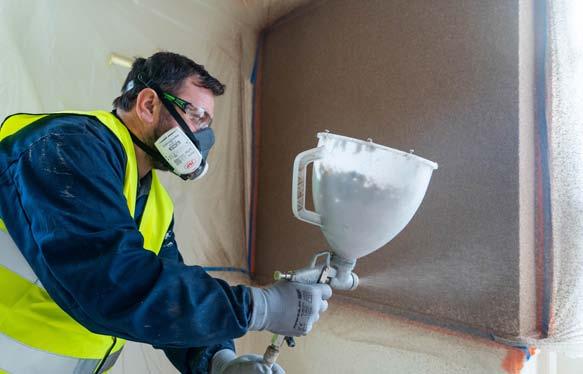
• Penetrating damp is caused by water penetrating through walls, roofs, or windows. It’s important to identify where water is coming from to eliminate the root cause. This could mean repairs to your roof or windows, or it may be an issue with external walls.
• Condensation occurs when airborne moisture hits a cold surface. This moisture occurs naturally in the home through everyday activities, such as cooking, showering, and breathing. The moisture is held in damp, porous surfaces that provide the perfect environment for mould to develop.
How does this lead to mould?
Mould spores are tiny structures produced by mould in order to reproduce and grow. They’re incredibly small, meaning they can float in the air unseen, and they are constantly in the air. They are allergens which can cause various allergic reactions –which is why inhaling or touching them can cause health issues or make existing conditions worse. But they only become an issue when they have the right conditions.
Finding the solution
With damp and mould impacting indoor air quality, and increasing or aggravating the risk of allergic reactions, respiratory problems and immune issues that come with mould, finding a solution that prevents these in the first place is crucial.
SprayCork, from CorkSol UK, is a sustainable and eco-friendly sprayed cork coating for walls and ceilings that can eliminate penetrating damp and condensation forming on surfaces. It is an extremely thin coating, applied at 4-6mm with 2mm skim, which also increases the energy efficiency of the property, providing tenants a healthy and safe space to live, and peace of mind to the landlord.
The thin layer at which the product is applied makes it perfect for:
• Small rooms and tight spaces where thicker layers cause unacceptable reduction in room size
• Properties with historic internal architectural details, which should not be concealed behind thick layers of insulation for conservation reasons
• Properties on a tight budget, who do not want the extra cost, time and hassle of repositioning services such as electrical points and radiators
www.corksoluk.com
n REFURBISHMENT & MAINTENANCE 50 APRIL 2023 www.hamag.co.uk
Image © Adobe Stock
Image © Adobe Stock
Image © Corksol
“SprayCork, from CorkSol UK, is a sustainable and eco-friendly sprayed cork coating for walls and ceilings that can eliminate penetrating damp and condensation forming on surfaces.”
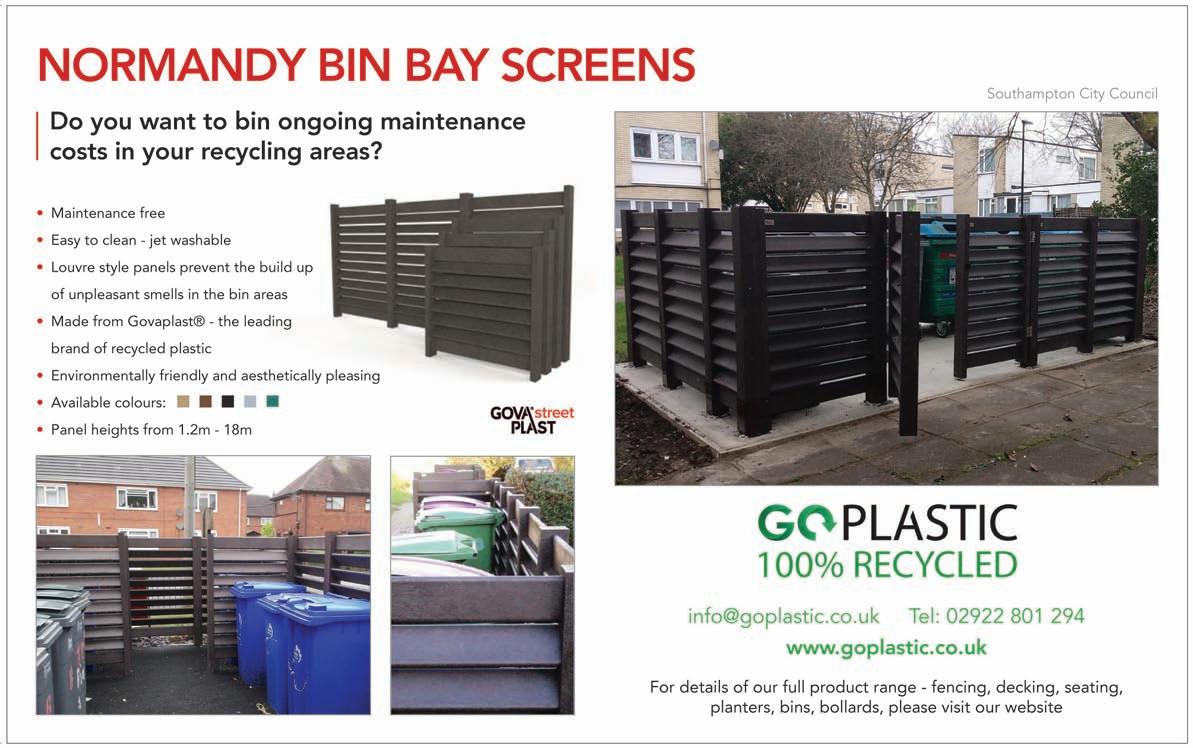

www.hamag.co.uk APRIL 2023 51
Pendock pipe boxing - keeping a low profile
The use of pre-formed boxings and casing for concealing pipework on social housing refurbishment projects has gradually overtaken the time intensive procedure of fabricating individual boxing on site, to become the preferred solution for most social landlords and contractors.
Traditional methods of concealing surface mounted heating system and boiler pipework typically involved the fabrication of boxing from wood or MDF. The need to cut the pieces to length then fix them to the wall, followed by sanding, priming, painting and sealing is extremely time consuming and costly, especially in terms of labour.
While the most obvious and persuasive advantages of using ready-made plywood boxing are the significant reductions in time and costs that can be achieved, aesthetics have also played an increasingly large role in the decision to adopt ‘pre-made’ over ‘site-made’.
The Pendock Profiles range of specialist casings is already a common feature in countless projects across the UK including heating system refurbishments, boiler upgrades and retro-fit fire sprinkler system installation.


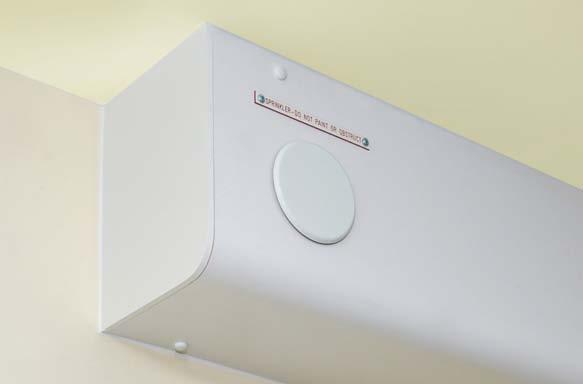
n Product range

MXF fire sprinkler boxing, TK pipe boxing and BC boiler casings are all manufactured from UKTR compliant pre-formed plywood, which enables Pendock boxing to be fitted in around half the time of site made alternatives. Also, they can be easily removed and re-fitted to aid routine inspection and maintenance without having to dismantle or break the boxing.
The TK pipe boxing range is designed primarily for use at skirting level and incorporates a 115-degree angle to the top of the profile, enabling it to ‘blend-in’ to the skirting and help it avoid being used as a step. A 3-sided version, the TKD, is also available, for mid-wall or vertical use, which incorporates the 115 degree angle on both sides of the profile.
n Smooth profiles
Pre-formed boxing is curved to form a smooth ‘L’ shaped profile, so there are no sharp corners or joints along the edges of the profiles, as is usually the case with site fabricated alternatives.
Also, due to the wide ranges of sizes available, the correct profiles can be selected to meet the dimensions needed for the project, so they can fit more closely over the pipework. This helps minimise the intrusion and visual impact in flats, where skirting level heating pipework or high level fire sprinkler systems are being concealed.
To add even greater versatility, Pendock’s pipe casings range includes a wide choice of sizes, which enables a consistent finish to be achieved in individual flats, even where different profile styles or sizes are installed.
This becomes more important where blocks of flats are being refurbished, as each one will have the same continuity of finish, which is much more difficult to accomplish with site made boxing.
In addition, all plywood profiles are pre-finished with a white resin impregnated décor paper, as standard, which removes the need for painting on site, saving even more time and further improving consistency of finish.
Like the MXF and TK ranges, the boiler pipe casings are manufactured from pre-finished and pre-formed plywood. Designed specifically to conceal unsightly boiler pipework, valves, filters and flues, they also allow easy access for gas safety checks, routine inspection or boiler maintenance.
Where exterior pipework needs protecting and concealing, the CHM and MXM metal pipe boxing range has been engineered to enclose building services and other utilities. Bespoke manufactured to individual project specifications from 2mm aluminium, as standard, metal boxing is used widely for concealing external pipework used in low carbon district heating schemes, as well as air-source and ground-source heat pumps.
Fire sprinkler supply pipework mounted in open balconies or externally to flats are also covered using metal boxing to provide added security and weather resistance. Also, as it is non-combustible, it is used in high rise residential blocks to conceal interior runs of pipework where no sprinkler heads are present, such as communal areas.
Details on the full Pendock Profiles family can be found on the company’s website along with downloadable drawings in PDF and DWG format, plus NBS specification clauses.
www.pendock.co.uk
Images © Pendock

n REFURBISHMENT & MAINTENANCE 52 APRIL 2023 www.hamag.co.uk
MXF sprinkler boxing
BC plywood boiler casing
MXM metal boxing
TK pipe boxing
Climate Change, the Cost-of-Living Crisis and Water
Climate Change, the Cost-of-Living Crisis and Water
In the UK water conservation has been largely ignored since the summer of 1976 – until now. The impact of erratic rainfall patterns has highlighted the wider impact of overuse of water resources.
Even in the UK the change in weather patterns due to global climate change have resulted in, mostly, short term supply issues. In addition to these ‘direct impacts’, the process of cleaning, processing, and heating water accounts for 6% of CO2 emissions in the UK.1
Approximately 17% of energy used in the home is to heat water.2
Research had shown that the water efficiency message has little impact on behaviour. The relative cost of water is low, so monetary savings in not a good incentive. However, to many, the more immediate issue is energy prices.
n Water Meterssupporting behavioural change

On average, people reduce consumption by around 33 litres per day if on a water meter.
Metering is not always easy; many properties have architectural or water supply structures that make traditional metering options impractical. In these cases, Groundbreaker water management system is the best option. The insulated, surface mounted enclosure and point of entry location makes it the perfect solution for installation in existing properties with shared supply or challenging architecture. Its location on the building also means no street furniture or liability in the highway.
Another advantage is the single joint free connection. Compliance with no joint policies has been shown to contribute to minimising leakage, which can cause issues to both the property owner and water provider. It meets the best recommendations of Water UK and the Home Builders Federation3. In some water company areas, such as Portsmouth Water, Groundbreaker is the standard required for all new properties.
Groundbreaker also future proofs the network. The stronger communications signal strength relative to underground meter installation makes it ideal for future ultra-smart (5G) two-way metering and ‘internet of things’ (IOT) technologies.
n Controlled flowunconscious consumption reduction
Whilst water efficient appliances, like dishwashers and washing machines, can reduce domestic water and energy usage, much hot water is used in ‘time controlled’ usage e.g. showers or rinsing dishes. ‘Time controlled’ usage can use excessive water, its reduction is the major means of reducing daily water usage.
Water companies are regulated to provide a minimum level of water, but in many areas due to network structure and gravity fed systems supply is much greater – upto three times the minimum. So run a hose for five minutes at the bottom of the hill, and your lawn will be greener that the gardener that does the same at the top.
The simple measure of regulating the flow and pressure of the water supply to a property has been shown to significantly impact household usage.
Groundbreaker’s NRv2 LoFlo modulates the level of flow entering premises, reducing the amount of water used in ‘time controlled’ applications. There is no degradation of service, and more importantly no intervention or behavioural change on the part of the customer, leading to ‘natural’ reduction in consumption.
Independent research carried out by WRc, showed a theoretical reduction of 2-4% of typical water usage when devices such as LoFlo are installed. However, recent field trials by a major UK water company have shown savings of 5% - just 1% off the average UK per capital consumption reduction targets!
The NRv2 LoFlo can be easily and simply retrofitted to any meter installation, or meter exchange when upgrading or remediating underground meter chambers. Thus, allowing water demand management with little or no impact on consumers and at minimal cost.
Groundbreaker Systems have been an innovator in the water industry for over 20 years and their products have a proven track record. Groundbreaker Systems have always worked with the aim of reducing the environmental impact of the industry through its products and manufacturing methods.


For further information on the Groundbreaker products visit www.groundbreaker.co.uk
 Steve Leigh, Managing Director Groundbreaker Systems
Steve Leigh, Managing Director Groundbreaker Systems
1. Environment Agency (2008): Greenhouse gas emissions of water supply and demand management options, Science Report – SC070010 2 https://www.theccc.org.uk/wp-content/uploads/2019/02/UK-housing-Fit-for-the-future-CCC-2019.pdf

3. For further information, check the Home Builders Federation Guidance. https://phpdonline.co.uk/news/watersafe-partners-with-the-home-builders-federation-to-reduce-water-leaks-in-new-properties/

www.hamag.co.uk APRIL 2023 53
Groundbreaker Systems won the HBF’s ‘Utility of the Year’ in 2018.
Groundbreaker’s NRv2 LoFlo Image © Groundbreaker
“The simple measure of regulating the flow and pressure of the water supply to a property has been shown to significantly impact household usage.”
Image © Adobe Stock
Trade body reports 2022 as the ‘year of condensation’
A national trade body has reported the highest level of condensation affecting homes in 2022.


The Property Care Association has seen a record increase in the number of condensation-related claims made by householders across the UK, with reports continuing to be logged in 2023.
According to experts at the trade association, cold weather snaps, inflation, the cost- of-living situation and increases in energy heating prices are all behind the surge in damp and mould.
Steve Hodgson, chief executive of the PCA, said: “2022 has turned out to be the worst year ever for condensation issues on record in our 93-year history.

“Our 400-plus members are seeing a significant rise in problems with excess moisture in properties across the UK in social housing, as well as the private domestic sector.
“There have been a number of contributing factors, which collectively have had an impact.
“The tragic events in Rochdale and the subsequent media coverage appear to have created a shift in public tolerance to damp and mould issues. We are now less accepting of dampness and reporting issues in greater numbers than ever before.
“We have had a number of cold weather spells, as well as the cost-of-living issue, soaring energy bills and inflation, all of which have lead people to economise on their heating.
“Efforts to reduce air leakage through draught proofing and retrofit insulation, as well as the changing climate patterns - featuring wetter weather – are also of significance.
“Increasingly, people are working from home too, and that change in occupancy patterns can also have an impact.
“A little bit of mould in the home is nothing to worry about, but what we are seeing needs to be considered more seriously.
“It impacts on physical and mental health, and we need to look at what can be done to stop this problem continuing to escalate.
“We believe the frequency of problems associated with damp and mould from indoor air is only set to get worse, with unseen and as yet underestimated problems being created due to these new pressures on properties.”
According to the PCA, ventilation is critically important to tackle problems emerging in a new generation of humid homes, but it says the current system is failing to tackle the issue.
Steve Hodgson added: “Key to addressing the issue is the installation of appropriate and efficient ventilation.
“However, despite the impact that good ventilation can have on a property’s moisture levels, the current regulation and guidance setting out minimum requirements in homes is mixed and usually ignored or misunderstood.
“This needs addressing as a priority, as a great many of the problems faced could be improved through the correct use of appropriate ventilation strategies.” Of concern to the PCA is the current format of Approved Document F, the Building Regulation which addresses ventilation in homes.
James Berry, the PCA’s Technical Manager added: “Approved Document F does not get the attention it deserves and is not enforced to the same extent as
“We believe the frequency of problems associated with damp and mould from indoor air is only set to get worse, with unseen and as yet underestimated problems being created due to these new pressures on properties.”
other areas of the Building Regulations, but the effects of failing to provide adequate ventilation should be taken much more seriously.
“We conducted a poll during a recent webinar on ventilation and over 72 percent of the delegates believed less than 30 percent of installs in new builds complied with building regulations.
“It is our belief that unfortunately the situation is much worse in our existing buildings so, if we are struggling to get this right in new builds, we need to question where the infrastructure is in place to ensure quality and compliance across our existing housing stock.
“The scale of the problem of poorly ventilated houses is potentially hugely significant.
“This was one of the core reasons we set up our Residential Ventilation Group to promote greater compliance with Building Regulations when installing ventilation systems.
“Over the years the Residential Ventilation Group has pressed for more robust Building Regulations to tackle the issue and will continue to make the case for these changes to be made.”
n HA ARTICLE 54 APRIL 2023 www.hamag.co.uk
www.property-care.org
Condensation on window
Mouldy wall
Steve Hodgson, chief executive of the PCA
Images © The Property Care Association





















































































































































 Steve Leigh, Managing Director Groundbreaker Systems
Steve Leigh, Managing Director Groundbreaker Systems





